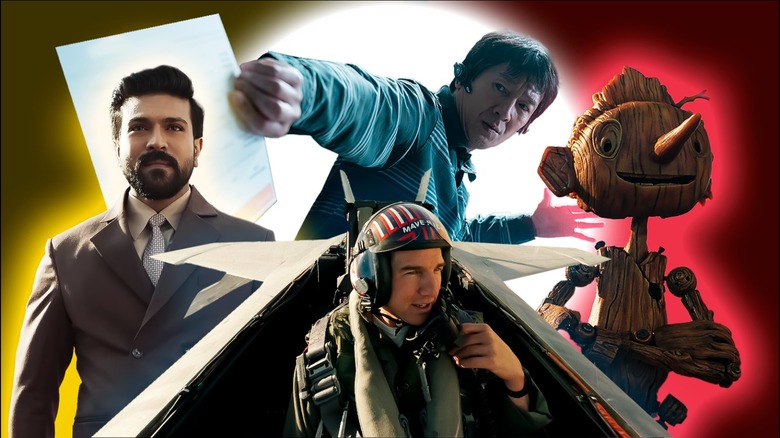
Every year, the /Film crew gathers together to debate, argue, and sometimes even agree on the 50 best moments of the year in cinema. The result: a mammoth list celebrating the best movie moments of the past 12 months. Incredible moments from great movies. Amazing scenes in overlooked films. Brilliant specks in otherwise bad films. They're all here, and they all represent a year that saw Hollywood and international cinema alike bounce back from the pandemic and deliver a slate of films that reminded us why we love this medium so much in the first place. Let's finally close the book on 2022 in style: with wood puppets and fighter jets, with multiverse-jumping and grisly horror kills, with "RRR" and, well, "RRR."
Naturally, this article is full of spoilers. To the brim. Overflowing, even. If it was released in 2022, it could be spoiled in the list below. Proceed with caution.
Note: if you're wondering why a certain moment didn't make the list, you can listen to our two-part podcast series where we trimmed down this list from nearly 200 possibilities, bickering the whole way.
50. Navalny Prank Calls His Own Would-Be Assassin In Navalny
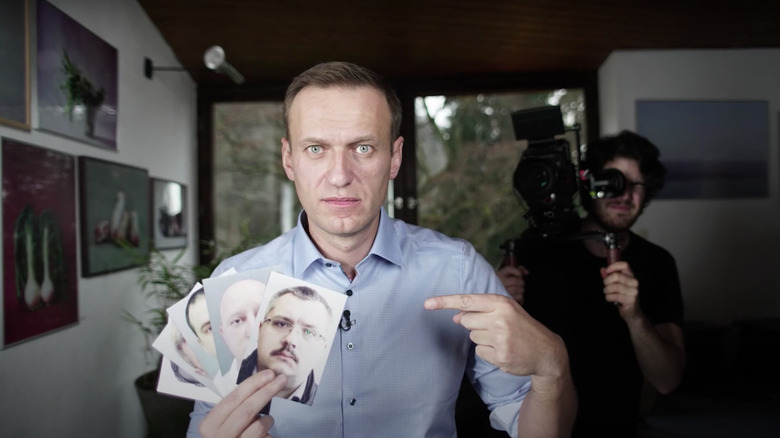
At times, "Navalny" feels more like a Bourne movie than a documentary. The film, which tracks the journey of a Russian politician who proved to be a genuine threat to Vladimir Putin's iron grip on the country, is a mixture of talking-head interviews with Navalny and his cohorts, plus incredible behind the scenes footage taken by his family and close advisors as he survives a poisoning attempt that was orchestrated by the Kremlin. In the film's most staggering moment, Navalny, who has a savvy social media presence despite being middle-aged, turns on the cameras, calls one of the idiotic goons who tried to kill him, poses as someone else, and actually manages to get the guy to admit to the assassination attempt. The conversation plays out on speaker phone, and when the admission finally comes, Navalny and his team look at each other in astonishment: I can't believe this moron actually admitted it over the phone. It's a huge moment, not only for Navalny's personal narrative, but for international politics as well. It's one of the most jaw-dropping things I've ever seen in a documentary, and it's played like something straight out of a spy thriller. I still can't believe it happened. (Ben Pearson)
49. The Nail Gun In No Exit
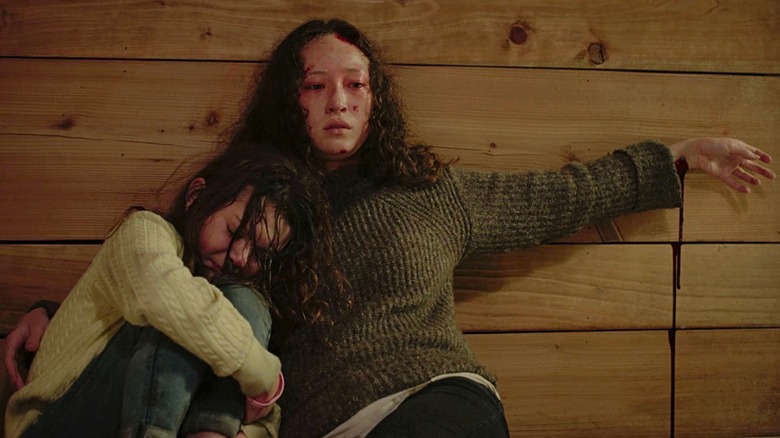
Full disclosure: the following moment isn't actually the best moment involving a nail gun in "No Exit." The actual best nail gun moment is so incredible, so darkly laugh-out-loud hilarious, that I don't want to spoil it for anyone who hasn't seen this movie yet.
If you've never even heard of this movie, that's no surprise. This one-location thriller from director Damien Power ended up being rather unceremoniously dumped to streaming (Hulu in the US, Star+ in Latin America, and Disney+ in other international markets) without much fanfare or marketing. But if you haven't seen it, check it out. It's a tight 90 minutes without an inch of fat on it: just a group of strangers trapped in a visitor's center by a snowstorm, with dark secrets among them and bad things a-brewing. If you're a fan of bottle episodes (and/or "The Hateful Eight"), this one is for you.
Havana Rose Liu plays the protagonist, Darby, a drug addict who broke out of rehab to try and reach the hospital where her mother is in critical condition following a brain aneurysm. After things go south in the visitor's center, Darby ends up getting nailed to the wall (in the literal sense, not in the fun, figurative sense). In order to free herself, she jumps off the wagon and snorts heroin to numb the caring-about-pain parts of her brain, then pries the nail out of her wrist with a claw hammer before using the other end of the hammer to whack one of the bad guys in the head.
Look, I'm not saying that snorting heroin and hitting people with a claw hammer is badass in general. This is not an endorsement of heroin and/or hammer-related violence. But in this specific scenario ... yep, it's pretty badass. (Hannah Shaw-Williams)
48. Simon And Patty Write 'Watermelon' In Dinner In America
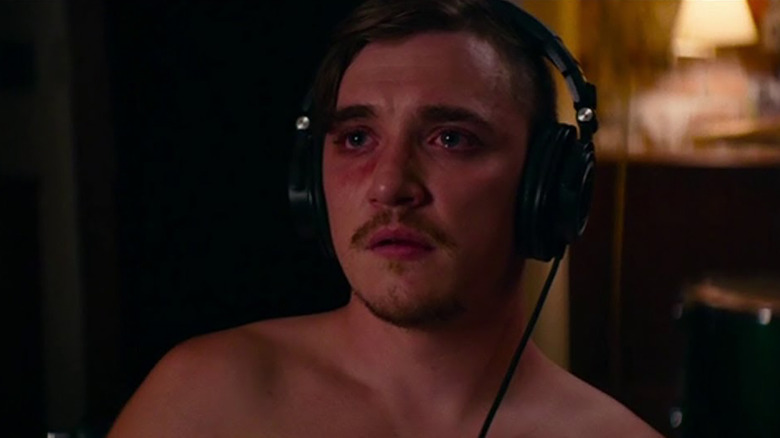
The vast majority of films about punk rock and the punk scene in America take place in Los Angeles or New York City. With very few exceptions, the Midwest and other so-called "flyover" states are left out of the cinematic conversation about countercultures. Adam Rehmeier's fantastic "Dinner in America" explores the budding relationship between a pyromaniac named Simon (Kyle Gallner) who moonlights as a ski-mask-clad punk singer named John Q with a massive local following, and a socially awkward, sheltered girl named Patty (Emily Skeggs), who is a massive fan of underground punk music. At first glance, Simon and Patty look like total opposites, but their union becomes a punk rock love story for the ages.
After the two skip out on Patty's job interview as a dishwasher, they break into Simon's family home to make music where he reveals that he's John Q. Patty is overwhelmed by the information, and the two finally have sex just before Simon suggests they turn one of the fan letters Patty has written "John Q," into a power-pop song. The result is "Watermelon," a catchy, beautiful song with the motto "f*** 'em all but us." Watching the two of them put the song together is one of the best visual showcases of what it means to fall in love, and watching Patty's voice become the key to melting away Simon's hard exterior is nothing short of brilliant. (BJ Colangelo)
47. That Final Stretch Of Deadstream
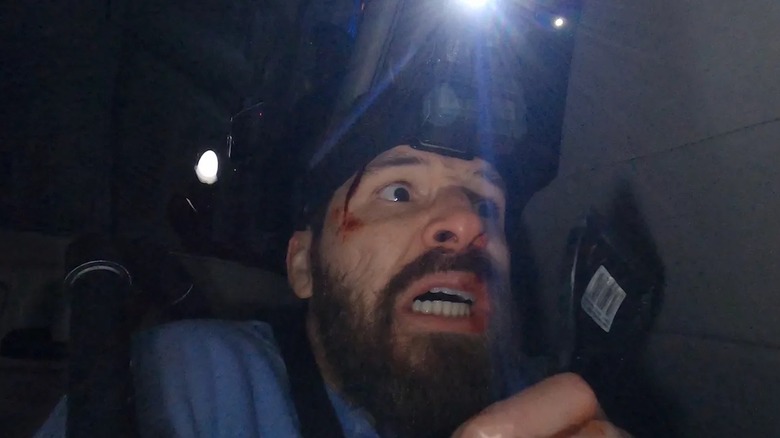
Just when you thought the found footage horror movie was out of tricks, "Deadstream" shows up to give the entire subgenre a wicked (and wickedly funny) shot in the arm. Directors Vanessa and Joseph Winter fill their feature debut with maniacal energy, gross-out gore, and a wicked wit, and it all comes to a head in the final scenes, where obnoxious YouTuber Shawn (Joseph Winter) ventures back inside the cursed cabin where he's been conducting a ill-fated haunted house tour to confront and destroy the evil that has upended his life (and livestream). The Winters, both onscreen and off, prove themselves as adept as Sam Raimi and Bruce Campbell at mixing terror with slapstick, as Shawn absorbs all manner of horrifying and bleakly funny abuses as he confronts a being of malicious evil who delights in tormenting him. "Deadstream" is a terrific movie before its final scenes, especially in how it truly engages with modern video tech to refresh the found footage format, but it sticks the landing with a riotous climax that will make "Evil Dead" fans praise the Necronomicon. (Jacob Hall)
46. Every Line From Rachel Sennott In Bodies Bodies Bodies
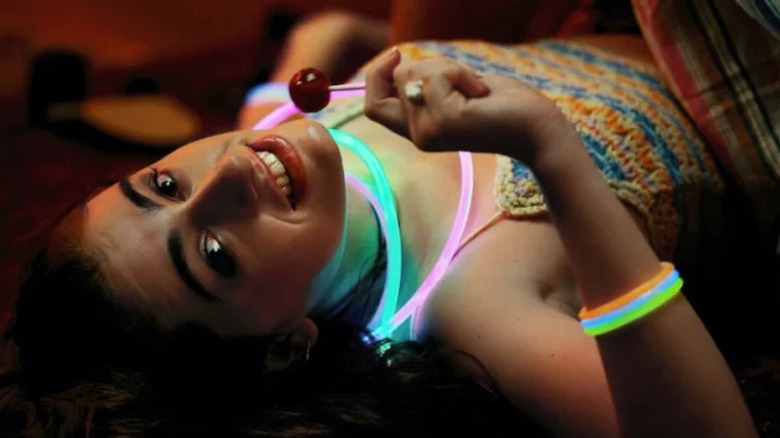
It's impossible to pick just one Rachel Sennott line from "Bodies Bodies Bodies" worth celebrating, because the actress who embodies Gen-Z podcaster Alice turns the TikTok-era combination of overt ditziness layered with occasional, surprising cleverness into an art form. Whenever Alice opens her mouth, the needle on "Bodies Bodies Bodies" starts to spin from horror back to comedy, and she gives the film the quasi-campy sheen that makes its group trip from hell get more uproarious as it gets more chaotic. "I have body dysmorphia" she admits when her friends are about to kill her. "Your parents are upper-middle-class" she spits during an argument, and if this were a video game, we'd see a KO-ed sign over the exchange. At a certain point, "Bodies Bodies Bodies" had me less invested in who the killer is than in what Alice was going to say next. (Valerie Ettenhofer)
45. The Bedroom Murder In Terrifier 2
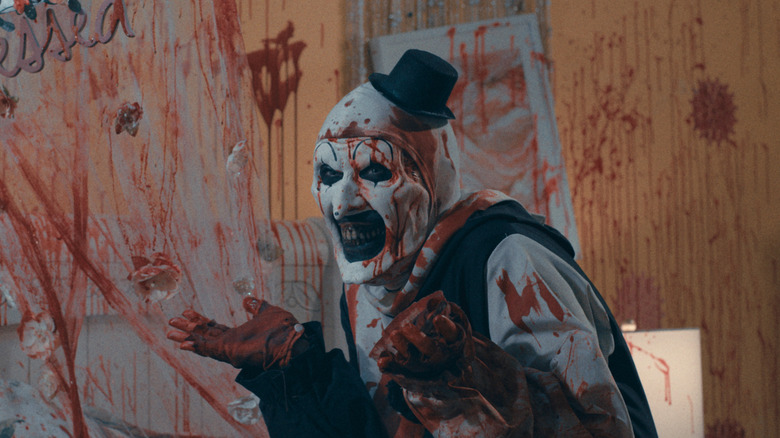
Think of the most grotesque, brutal, yet oddly hilarious death scene in a movie from the past year. You thought of the bedroom scene in "Terrifier 2," didn't you? You wouldn't be alone in this, because we've been thinking about this particular death scene since its official release. When Allie (Casey Hartnett) gets a visit from our good friend Art the Clown (David Howard Thornton), she gets flayed, beaten, and scalped -- all of this, by the way, is made so much worse because she's getting bleach and salt rubbed on her wounds. Doesn't that just make your skin crawl? Well, at least it does to us.
While undeniably a cruel way to kill a well-meaning character like Allie, the sheer absurdity of it makes it hard to take seriously. It's like an ultra-violent "Looney Toons" cartoon come to life, with increasingly brutal methods of torture. He really might as well have pulled out a massive hammer and bonked the girl with it. The kicker of all of this is that, even after getting flayed and torn from limb to limb, Allie is never actually seen dying -- by the time her mother comes home, she's still conscious. Yes, this scene, and all of "Terrifier 2," is gratuitously gory, but it is also purposefully played for shocked and uncomfortable laughs. That self-awareness is what elevates it from needless filler to one of the most memorable kills of 2022. (Erin Brady)
44. The Heartbreaking Reveal In Breaking
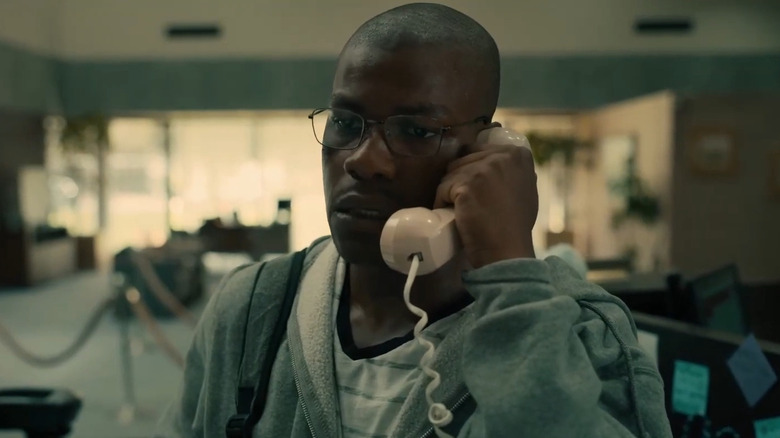
Greatness is, so often, achieved in underseen films. Such was the case with "Breaking," director Abi Damaris Corbi's account of veteran Brian Brown-Easley (John Boyega), who is desperate for cash and is owed back payment from the VA. In his desperation, he decides to hold up a bank until his demands are met. For most of the movie, this man has no desire to hurt anyone, yet the specifics of his demands are a bit vague. Despite the circumstances, the viewer sympathizes with him. Heading into the movie's third act, we get a devastating reveal as Brian is speaking with the lead negotiator, Eli (Michael K. Williams) in an attempt to bring this all to a close. We see flashbacks of what happened to Brian at the VA when he was trying to get the money owed to him. It's difficult to watch, as Boyega heartbreakingly comes to understand he's probably not getting out of this alive. The real gut punch, though, comes when Eli asks how much money Brian is owed. The answer? A mere $892. Less than $1,000 drove a man to such extremes. It's a brutal moment of devastating realism, illustrating just how broken the system, as it exists, can be for veterans. Cinematically speaking, we're so accustomed to people robbing banks wanting large sums of money. Here? Brian isn't greedy, he merely wants the little money he is owed to help get him back on his feet and gain access to his family. (Ryan Scott).
43. The Monster Reveals Itself In Smile
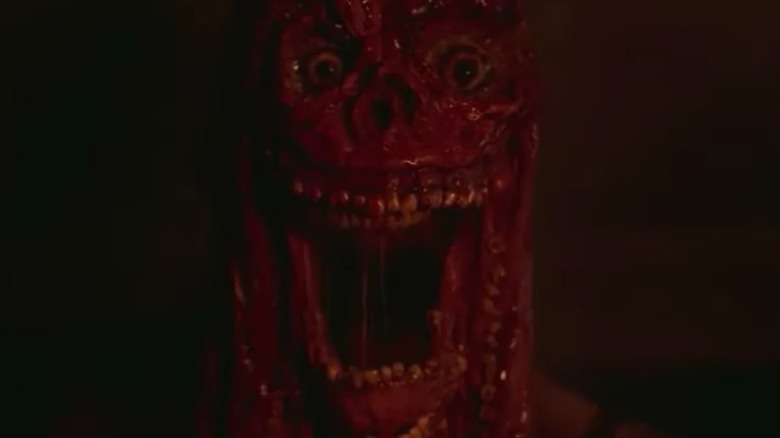
Writer/director Parker Finn's "Smile" often paints by the numbers, pulling in familiar scenes, reveals, and rhythms from some of your favorite horror movies. But that may be the whole point -- the film is so damn scary that those recognizable elements are the closest thing this bleak and brutal shocker offer to a comfort blanket. However, Finn burns that comfort blanket to cinders with the final scenes, where Sosie Bacon's Rose confronts the malevolent force that has been driving her to die by suicide and it... Well, it reveals itself. First taking the form of Rose's dead mother (oversized and crouching through doorways, a haunting image), it then takes the title of the film a bit literally as it tears its own face open, revealing face upon face, mouth upon mouth, smile upon smile. We only see this true form for a few seconds, but it's gnarly and shocking enough to send you into the closing credits screaming. (Jacob Hall)
42. The Panda Fight And Boy Band Duet In Turning Red
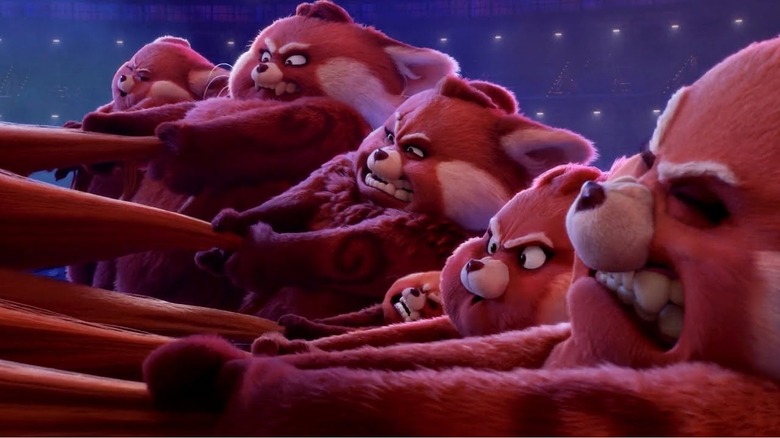
Is there any other movie where middle-aged aunties get to be superheroes? Pixar's "Turning Red" might be the studio's most blatantly feminine story yet, focusing on the dynamic between girls and women in different relationships: teenage friends, extended family, and more importantly, mothers and daughters. The animated film is full of moments that resonate with me deeply, but none more so than the frustrated (and repressed?) mom Ming (Sandra Oh) losing her temper and going after her rebellious daughter Mei Mei (Rosalie Chiang). Sure, I don't become a kaiju-sized panda who tears apart the Skydome (R.I.P.), but sometimes it sure feels like it.
The big showdown in "Turning Red" is a surprisingly empathetic one. Sure, we get older women embracing their inner beasts (always great to see) as well as 13-year-old Mei Mei embracing both her burgeoning sexuality and her independence, but the overall message her is clearly one of community. Ming isn't a villain despite being in the antagonist role: she's a person overwhelmed by emotion who needs help. And she gets it, not just from her daughter and her sisters and mother, but also from the downright angelic 4Town, rising from the ruins to unite a crowd. They sing from the heart. (One even cries!) Everyone joins in the mashup — an unexpected bop, I might add — and the day is saved. Rather than resolve the conflict with violence, it gets resolved with love — and I think that's really wonderful. (Sarah Milner)
41. Tony Hawk Tries To Land The 900 In Tony Hawk: Until The Wheels Fall Off
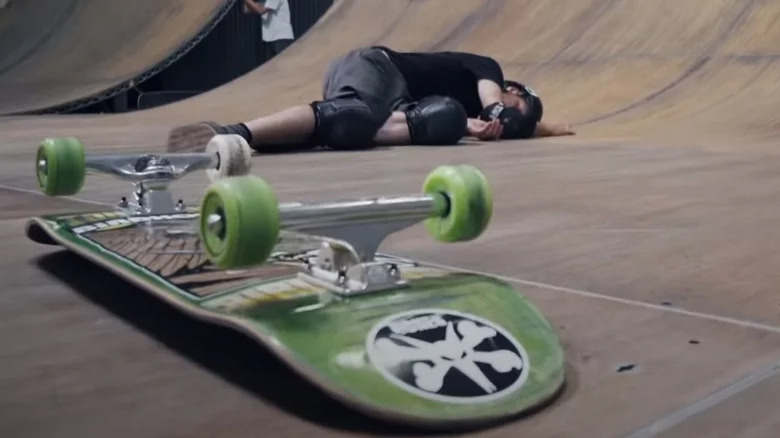
"Tony Hawk: Until the Wheels Fall Off" is a fairly typical documentary about the man who will go down in sports history as the greatest skateboarder of all time. But aside from all the details we learn about Hawk's upbringing and his rise to skateboarding stardom, it's the first five minutes of this doc tell us everything about who Tony Hawk is as both a man and an athlete, for better and for worse.
The film begins with Tony Hawk entering a halfpipe in the middle of a skate park warehouse. After a couple ups and downs, he tries to land The 900, the most difficult trick in skateboarding, which he pioneered many years ago. It's a 2½-revolution (900 degrees) aerial spin, and it's unbelievably difficult to pull off. Hawk proves this by trying over and over again, falling repeatedly. Sometimes he screams in anger or pain (probably both), other times he stops and lays on the ground in frustration. Who knows how many times he's attempted this trick before we started watching, or how many attempts ended up on the cutting room floor. But the couple dozen times we see him fail at this trick are brutal enough to witness.
This shows you exactly how dedicated Tony Hawk is to skateboarding, even to a fault. This is a man who is the poster child for professional skateboarding, having lived through the sports ups and downs, even when it was on the verge of death, and he doesn't have it in him to give up. But that also comes with a toll on himself, not just his body, but his family too. Hawk's life has been defined by skateboarding, and no one can stop him from landing a trick if he puts his mind to it. His dedication to skateboarding is both his finest achievement and his greatest flaw, but he's going to keep boarding until the wheels fall off. (Ethan Anderton)
40. 'I Don't Do Cocaine' In Do Revenge
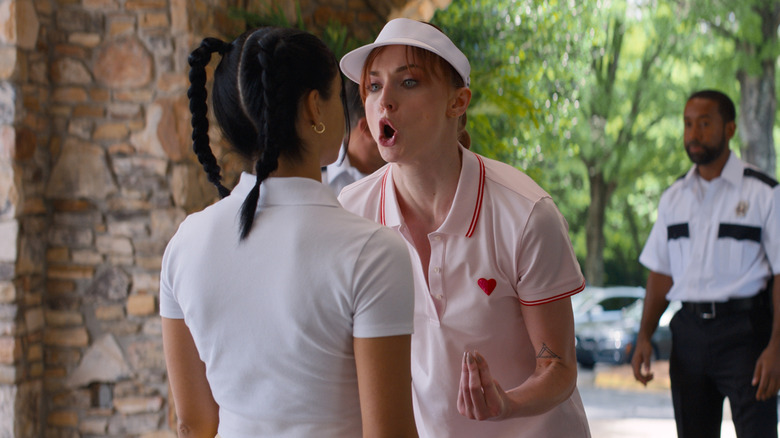
We often talk about folks like Daniel Radcliffe or Robert Pattinson, who after making a name for themselves in a massive, culture-changing franchise, go off to act in whatever weird projects tickle their fancy. Fortunately, after last year's teen comedy, "Do Revenge," we can now add Sophie "Sansa Stark" Turner to the roster. Turner's role on "Game of Thrones" turned her into an international superstar, but one that become synonymous with the role that made her famous. In the years post-"Thrones," she became young Jean Grey in "Dark Phoenix" and appeared in the limited series, "The Staircase." She did lend her voice to Princess Charlotte in the animated series "The Prince," but for the most part, her live-action roles haven't felt like a huge jump from the seriousness of "Game of Thrones."
Which is why seeing her lose her absolute f****** mind in "Do Revenge" while she screeches, "I DON'T DO COCAAAAAAAAINE!" so unbelievably hilarious. Turner plays a mean girl named Erica in this teen twist on "Strangers on a Train," who is framed for doing drugs and sent off to a rich rehab facility. As she leaves the school, she unloads with a frenzy — swearing, screaming, and practically bugging her eyes out of her head. It's a hilarious delivery by Turner who immediately needs to be given the chance to lead a comedy film, and proof-positive that she is capable of so much more than playing Sansa Stark. (BJ Colangelo)
39. The Creation Of My Bologna In Weird: The Al Yankovic Story
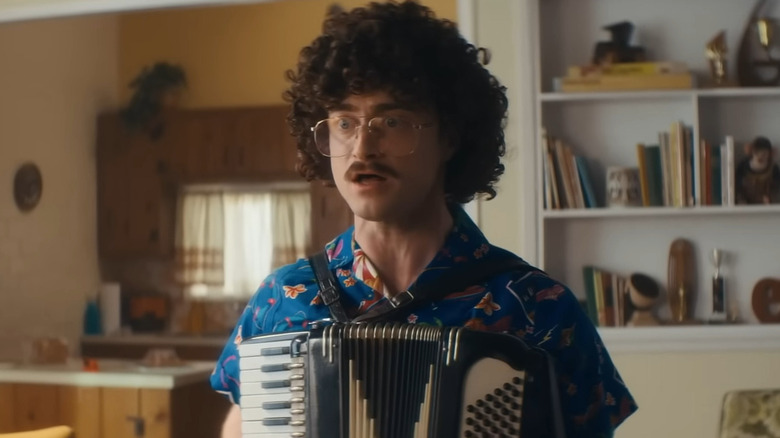
"Weird: The Al Yankovic Story" may not be quite the media darling that 2022's other notable biopic was, but "Elvis" didn't feature the King doing glorious battle against Pablo Escobar, so let's just be honest about who the real winner is, here, okay? The Roku original film satirizes Alfred Yankovic's journey to musical stardom, choosing silliness over truth at every turn. In retrospect, I really shouldn't have expected anything different from a movie co-written by the guy who made his professional debut singing about lunch meat. Set to the melody and instrumentation of Knack's "My Sharona," Weird Al Yankovic's first parody, "My Bologna" takes center stage for a crucial moment early on in the film.
In the scene, Al (Daniel Radcliffe) and his three roommates, Jim (Jack Lancaster), Steve (Spencer Treat Clark), and Bermuda (Tommy O'Brien) are lounging around their home, just guys bein' dudes, dudes bein' guys. After confessing his deepest yearning to make up new words to a song that already exists, Al agrees to scrounge up some lunch for his friends. The lunch in question is bologna sandwiches. "My Sharona" is playing on their radio. Al's accordion is within arm's reach. It doesn't get more diegetic than that. Al puts the pieces together and bursts into passionate prose. The best part? Everyone treats Al's spontaneous lyrical creation like he just unveiled the hidden meaning of life, with shock and awe and earnest enthusiasm. It's endearingly wholesome. (Cameron Roy Hall)
38. A Journey To Hell In Babylon
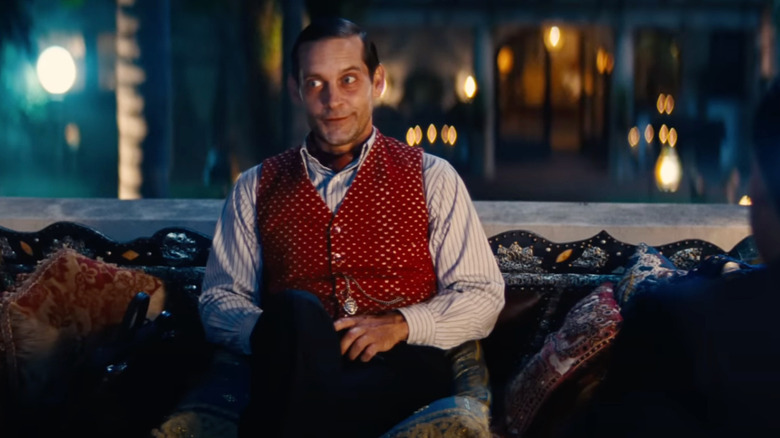
People seem to be extremely opinionated on "Babylon." Some think its an abomination, others say its worthwhile because it takes risks and goes big. I'm leaning towards the latter — I think "Babylon" is pretty damn good, albeit overlong. Near the end of this tale of Hollywood excess, main character Manuel "Manny" Torres (Diego Calva) has to repay a debt to a mobster. The mobster is played by Tobey Maguire, an actor you probably don't immediately think of when you hear "mobster." And yet Maguire, covered in sickly makeup and really going for it, is a hoot as this weird loony. Things go from bad to worse: the money Manny is using to pay off Maguire's character is fake prop money, a fact that could lead to Manny's death. But he can't get away, because Maguire's character drags him to an underground club full of all manners of debauchery. It's yet another wild and crazy scene in a film filled with them. (Chris Evangelista)
37. KC Is Part Of The Moon Now In Moonfall
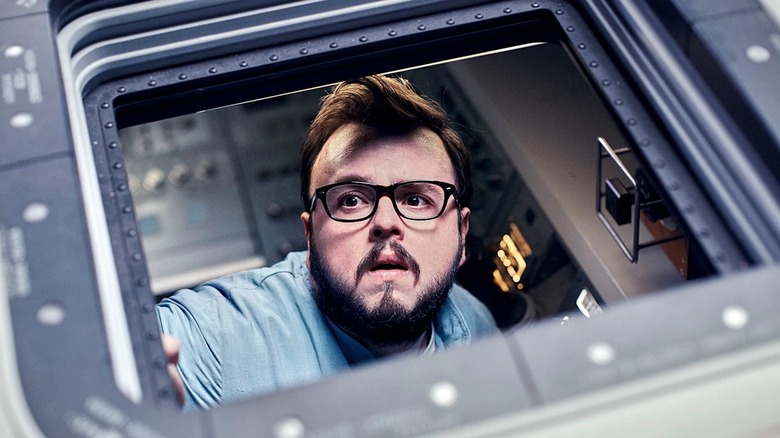
Roland Emmerich's "Moonfall" may be the single most ridiculous movie released in 2022, a film that tries to blend the hard sci-fi of Arthur C. Clarke with the world-ending mayhem of, well, a Roland Emmerich movie. But after total destruction of the earth has been averted and the moon (which is actually a spaceship built by ancient aliens to save the human race after a disastrous war against a rogue artificial intelligence) has been saved, we get a moment so utterly, so spectacularly, so beautifully dumb that it brands itself upon the brain. After sacrificing his life to save the moon, conspiracy theorist KC (John Bradley) wakes up, his consciousness having been uploaded to the moon's operating system. Now living in a blank white void alongside A.I recreations of his mother and his cat (named Fuzz Aldren!), KC is informed by the moon's equivalent of Siri that he's become part of the moon, and the fight isn't over yet -- it's time to "get started." Naturally, "Moonfall" was a massive box office bomb, and a sequel is never going to happen, but this may be the goofiest tease of all time, a moment that puts a glorious cap on a glorious slice of delicious hokum. (Jacob Hall)
36. Halloween Really, Really Ends In Halloween Ends
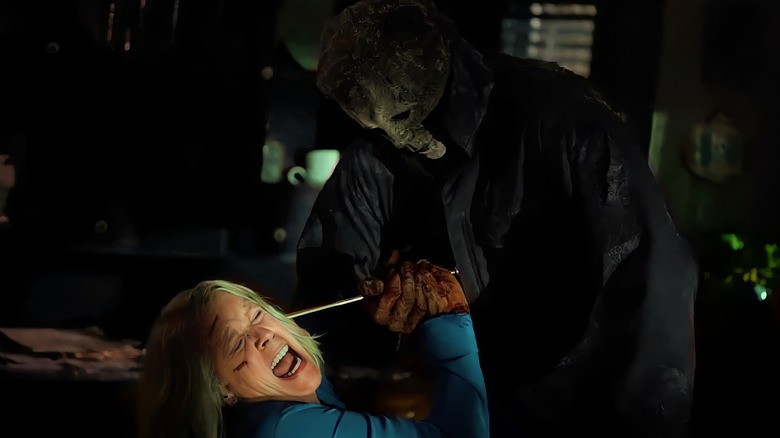
John Carpenter's 1978 "Halloween" is possibly the greatest horror movie ever made. It certainly gave the mainstream slasher new life and its killer, Michael Myers, has remained an enduring, cinematic icon for more than 40 years because of that film. And also because we've had nearly unending sequels and reboots ever since. That's how horror goes -- if there's money to be made, the killer is never truly dead. That's what makes "Halloween Ends" such a bold thing in the realm of mainstream horror. Director David Gordon Green decided to wrap up his trilogy that began with 2018's "Halloween" in a bold way: by truly ending it. Indeed, after one final confrontation with Jame Lee Curtis' Laurie Strode, Michael meets his demise in brutal, slow fashion. Green ensures there is no room for interpretation as he literally throws Michael's body in a shredder following the literal parading of his body through the streets of Haddonfield. Amazingly enough, evil truly did die that night. While there could be a reboot of some sort down the line, in perhaps a first for a slasher franchise such as this, the villain dies for good in a way he cannot just come back from, and we, the moviegoing public, got true closure. A bold move that is difficult not to respect, regardless of how one feels about the movie as a whole. (Ryan Scott).
35. 'Revolting Children' In Matilda The Musical
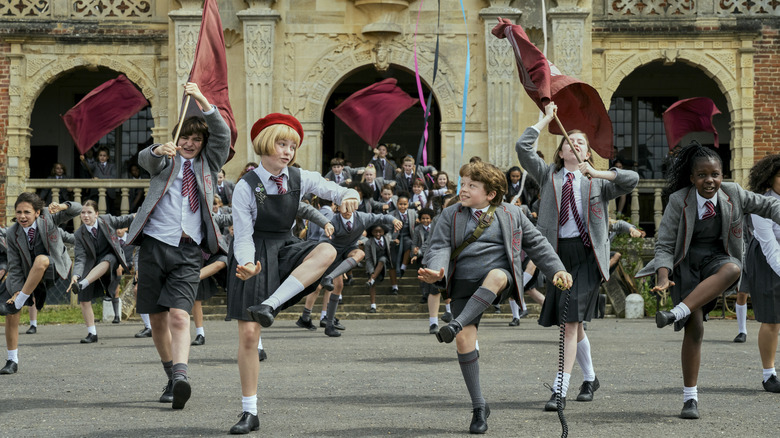
When the director of a stage musical decides they're going to make the film adaptation of that show themselves, the results are rarely good. Think about Broadway legend Hal Prince taking on "A Little Night Music" back in 1977 or, more recently, Phyllida Lloyd with "Mamma Mia!" The results are often leaden, with the directors not knowing how to use the camera to tell the story or capture the musical numbers in a dynamic way. Thankfully, Matthew Warchus does not fall into this trap when it came to the film adaptation of "Roald Dahl's Matilda the Musical."
I was dazzled by the exuberant and absurdly talented cast of child performers when I saw the show on Broadway in 2013. Usually, I'm someone very averse to precocious stage children, but these kids were so technically adept and actually felt like real kids. I was hopeful that Warchus would capture that same spirit in the film. He may have even taken it to a new level here, and nowhere is that better showcased than in the penultimate number, "Revolting Children."
Primarily led by Charlie Hodson-Prior and Meesha Garbett, this song by Tim Minchin is a shot of adrenaline of the highest order with these kids singing and dancing with as much skill as the most seasoned veterans. Ellen Kane's choreography is intricate and high-energy, and these kids don't miss a beat. Dramatically, the song's celebratory tenor also packs a punch. A perfect musical number. (Mike Shutt)
34. The Battle In The Woman King
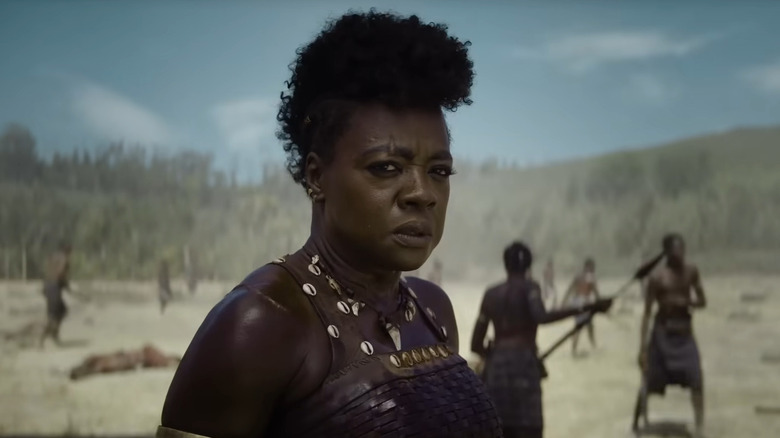
"The Woman King" is one of the few historical dramas where I didn't really mind all the liberties taken with the source truth. Partially because I had literally no idea what it was based on until after social media went rabid, but mainly because it's a damn good movie. Starring Thuso Mbedu, Lashana Lynch, Sheila Atim, and John Boyega, "The Woman King" is lead by Viola Davis who, as General Nanisca, radiates strength and gravitas. As the leader of the Agojie, an all-woman unit of expert warriors, she conquers her own fear to become the woman her people desperately need. But, until very near the end of the film, she's willfully ignorant towards adaptable warfare, something that Nawi (Mbedu), a new Agojie recruit, forces her to accept.
And, boy, when she comes to terms with a wider array of tactical combat, the Agojie become nearly unstoppable. In the penultimate battle against the Oyo, whose forces are larger and predominantly comprised of men, the Agojie expand their arsenal from just swords and spears to include anthills made out of gunpowder and well-hidden bombs. The Agojie level the playing field with a sweeping blaze and handily rout their enemies. Yes, the Agojie take losses, too, but nothing they don't pay back tenfold in finale, which sees them consume an entire city of slavers in fire and fury. Again, it's not even a little bit historically accurate ... compels me, though. (Cameron Roy Hall)
33. Looking In The Mirror In Good Luck To You, Leo Grande
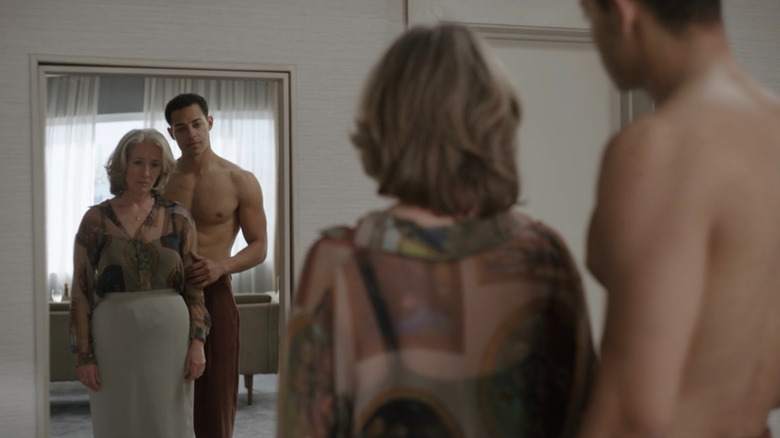
Regardless of gender identity, people tend to be their own worst critic when it comes to physical appearance. And despite more openness in parts of society about body image, it can still be extremely difficult to overcome and unlearn the insecurities someone has about their body.
In "Good Luck to You, Leo Grande," Emma Thompson plays Nancy Stokes, a former theology teacher that has never had an orgasm. Throughout the movie, she unpacks her difficult feelings about sex, shame, and her body with a young sex worker named Leo Grande (played by Daryl McCormack) over the course of five revelatory sessions. But they aren't just revelatory in the sexual sense. Though Nancy does learn about sex, the most important lesson is to accept and even love herself.
This graduation from her past self culminates in the final scene. After finally experiencing her first orgasm with Leo's (and a sex toy's) help, Nancy stands in front of a mirror fully naked and appreciates the way she looks. It's a short scene with no dialogue, but it says so much about how this character's evolution. Earlier on, Nancy says, "I've always been ashamed of myself. My body, I mean." But with a widening of her eyes and a simple smirk, Thompson speaks volumes about how lovely it can be see beauty in yourself. Not only is this a powerful moment delivered by a masterful actor, but it's an excellent reminder that we should all open up more and be kinder to ourselves. (Ben F. Silverio)
32. Lydia Tár Totally Loses Her S*** In Tár
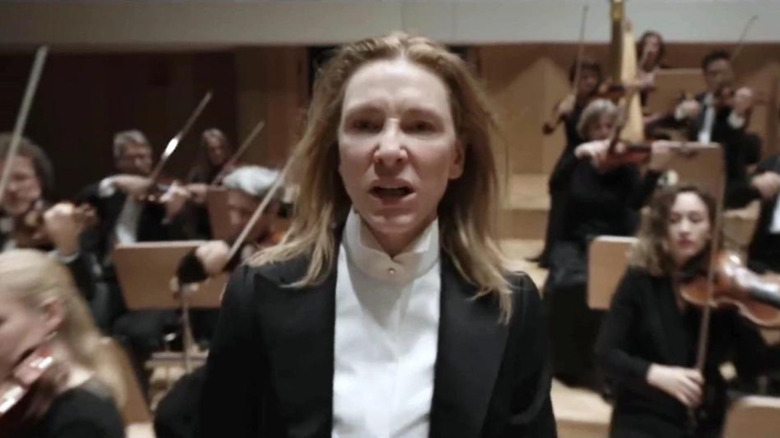
Lydia Tár (Cate Blanchett) may not be a real person, but her memory will live on in our hearts as one of cinema's greatest "pick-mes." While her film documents her downfall after her power-hungry and predatory ways get exposed, she originally handles things like one would expect: heavy denial and victim-blaming. However, the small setbacks that get in her way culminate into borderline hysteria, reaching a head when she rushes to the stage of a planned recording of Mahler's Fifth Symphony. There, she tries beating the daylights out of banker-turned-conductor Eliot Kaplan (Mark Strong) in front of hundreds of people.
Despite its straightforward story of a conductor's rise and fall, "Tár" is fairly abstract. A ghost story in more ways than one, much of its most pivotal moments have to be pieced together using context clues. If one were to simply watch the film without really paying attention to the dark and haunted spaces surrounding Lydia, one might think this beatdown comes out of nowhere. However, that couldn't be further from the case -- it symbolizes how, despite Lydia's insistence on self-reliance, she wanted to fit in with the men in her field so badly, she became one of them. The fight between her and Eliot not only showcases how bad her mental state has become since the sexual misconduct allegations surfaced, it highlights how unrecognizable being entrenched in such a toxic and predatory culture can make you. Her brother, Tony (Lee Sellars) was right -- Lydia forgot who she really was. (Erin Brady)
31. Silence Of The Lambs In Jackass Forever
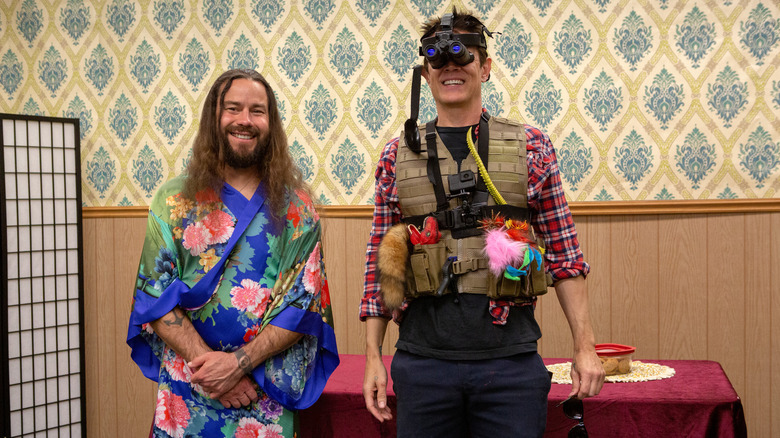
"Jackass Forever" is a rip-roaring last ride for the "Jackass" gang, giving Johnny Knoxville and the crew a chance to prank one another again before hanging up their hats on stunt work forever. There are plenty of great stunts and pranks in "Jackass Forever," but none of them embody the terrifying, hilarious chaos of the "Jackass" franchise quite like "Silence of the Lambs."
Based on the climax of the 1991 thriller, in which Jodie Foster tries to capture a serial killer in his own, pitch-black lair, "Silence of the Lambs" puts the "Jackass" guys in a room in pairs, tells them there is a deadly snake in the room with them, and then turns off the lights. Convinced they're caught in the dark with a cobra, the guys all freak out and try to get to safety. Unfortunately, Knoxville, Chris Pontius, and others are hiding in the corners with cattle prods and other torture tools to scare the living daylights out of their unsuspecting friends.
The real genius of the skit comes when Ehren McGhehey finds a door and thinks that he's managed to escape the nightmare, only to end up stepping on tacks and walking right into a frying pan hanging from the ceiling. Eventually Dave England just gives up, telling the crew that he "lives here now," refusing to leave the room after the lights come up. Making a "Jackass" call it quits is tough, but they did it. (Danielle Ryan)
30. The Final Escape In The Black Phone
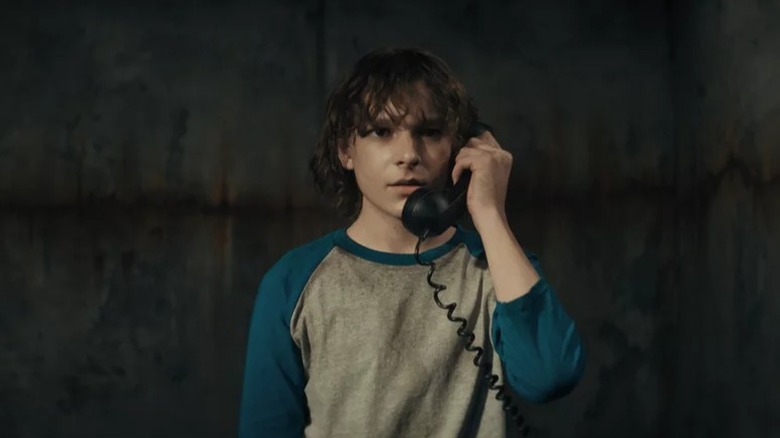
It takes a real level of tonal balance for a movie about a kidnapped kid to leave you cheering from your seat. In its best moments, "The Black Phone" achieves that balance, managing to scare and impress and somehow even delight despite its dark subject matter. Its climax does all of the above as Finney (Mason Thames) combines the tools he's been given by the ghosts of past captives to get the drop on the Grabber (Ethan Hawke). After the spirits give the Grabber a talking to over the phone he's so carefully avoided until now, Finney uses it to snap the man's neck.
At its core, "The Black Phone" is about the endless resilience of kids, and the dead pass the baton to the living for the last leg of Finney's escape, as his determined sister Gwen (Madeleine McGraw) finally finds him. "The Black Phone" pulls no punches throughout its runtime, so in the end, Finney and Gwen's hard-won reunion is one of the most cathartic moments in horror this year. (Valerie Ettenhofer)
29. The Opening Sequence In Athena
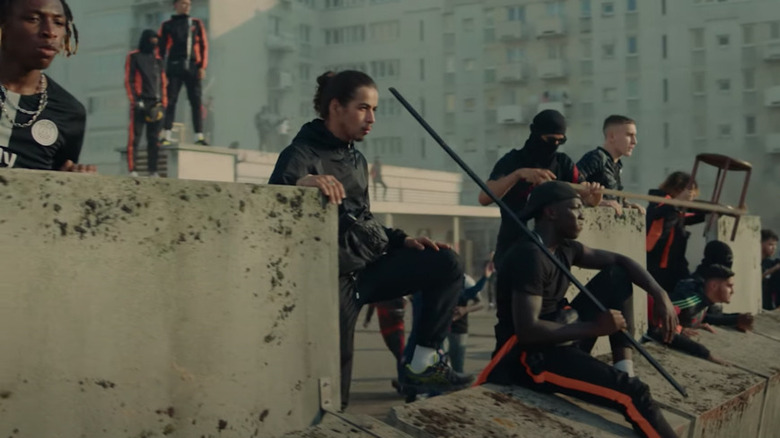
"Athena" is a movie that is built entirely out of long, complex, single-take sequences that put the coordination and production of most major blockbusters to shame. But it's the opening sequence from director Romain Gavras that's the most impressive.
The sequence begins with a close-up of Abdel (Dali Benssalah), a French soldier informing the press of the death of his 13-year old brother Idir, who has apparently been killed as a result of police brutality. Across the crowd, in attendance outside of the police station, is Abdel's younger brother Karim (Sami Slimane), who stands with a group of masked men. Suddenly, Karim lights a malatov cocktail and chucks it in front of the police station, igniting a fire. In the ensuing chaos, smoke billows, fire rages, an SUV drives straight through the station's front doors, and Karim's crew begins tearing apart the station. Try as police might to stop them, the gang raids the station, shooting roman candles that keep the police at bay, allowing them to grab a safe full of weapons. Yes, this is all still a single shot that snakes through the station.
But the sequence gets even more incredible as Karim and his fellow rebels hop into a police van and drive it all the way across town into their nearby neighborhood of Athena. Dirt bikes whiz pass, popping wheelies as the camera shifts from inside the driving van to outside on the street, never missing a beat of their escape. The sequence comes to an end by weaving through a rundown apartment complex being evacuated and turned into a fortress, with Karim and his crew standing in defiance on a nearby pedestrian bridge outside of their building. They're an army ready to do battle with the police. Again, all of this is accomplished in a non-stop 11-minute sequence that was actually achieved in a single take, and it's one of the most finely tuned sequences in film history. (Ethan Anderton)
28. The Monologue In Resurrection
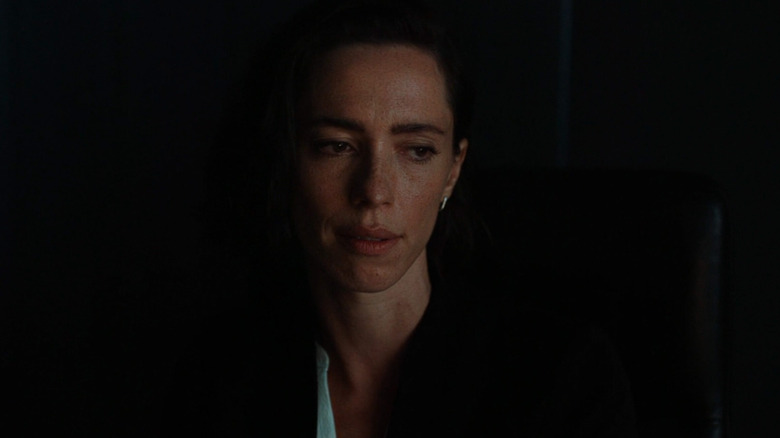
About 35 minutes into Andrew Semans' "Resurrection," Margaret (Rebecca Hall), a well-to-do businesswoman, is saying goodbye at the end of a workday to her young intern, Gwyn (Angela Wong Carbone). Just before the girl leaves, Margaret asks her a totally unprompted question: "You think you could kill someone?"
Gwyn's stunned, increasingly worried reaction is only the beginning — she makes the mistake of telling Margaret that she's "a really good listener." From there, Semans and Hall take us on a tour-de-force for the next nine minutes, the majority of which consists of an uninterrupted close-up of Hall delivering a monologue for the horror movie ages.
It's incredibly rare for an actor to be given so much space to themselves in a film these days, and even more unusual for a genre movie. Hall makes the most of the opportunity, recounting the story of Margaret meeting her ex and abuser, David (Tim Roth), and the ways the older man not only tortured her physically but psychologically, including convincing her that he consumed their son. The monologue is the key to the entire film, decoding the tense and mysterious first half and preparing us for the increasingly surreal back half. As the film continues, it calls into question whether Margaret or even the movie itself can be trusted. Whatever the case may be, Hall earns our ear, and Margaret's pain and madness are passed on to us. (Bill Bria)
27. The Final Battle In Avatar: The Way Of Water
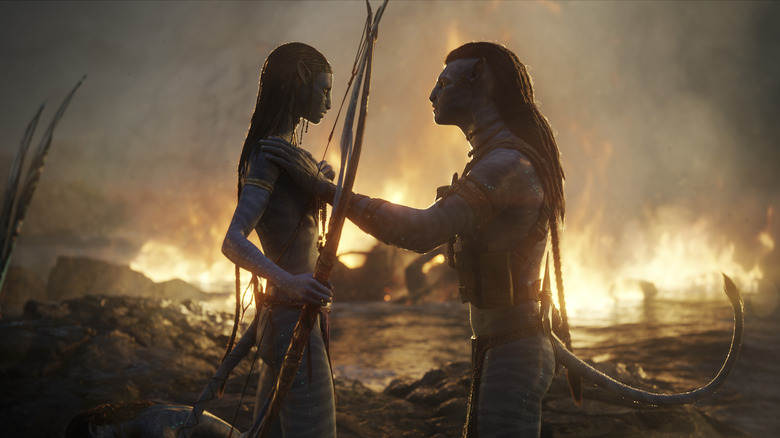
Okay, selecting a 45-minute battle scene as a "moment" might be cheating. But can you blame us? The finale of "Avatar: The Way of Water" is not only a masterclass in directing action by James Cameron, but it speaks to the greater thematic ideas in the film. For the entire third act, we are (literally) swept away by the hard-hitting battle that actually pushes the boundaries of PG-13. From the moment that Payakan attacks the SeaDragon ship, all hell breaks loose in the most satisfying way possible. The tulkun whale gets some payback, while the Metkayina clan finally joins the fight against the sky people, a culmination of two hours' worth of set-up. Above all, the emotional reunion between the Sully clan after suffering a tragic loss in the family makes this sequence one to remember.
The sinking SeaDragon is often considered a big nod to Cameron's previous film, "Titanic," but the setting also serves a greater thematic purpose. The mechanical beast that once poached the aquatic creatures sinks as a result of nature fighting back. However, it's not all positive. The remains of the SeaDragon will probably end up polluting the water, an inevitable consequence of humanity's involvement in the conflict. Yes, watching Payakan rip off a guy's arm was applause-worthy, but the raging fire beneath it all firmly places the final battle of "The Way of Water" on this list. (Marcos Melendez)
26. Performing For Mussolini In Guillermo Del Toro's Pinocchio
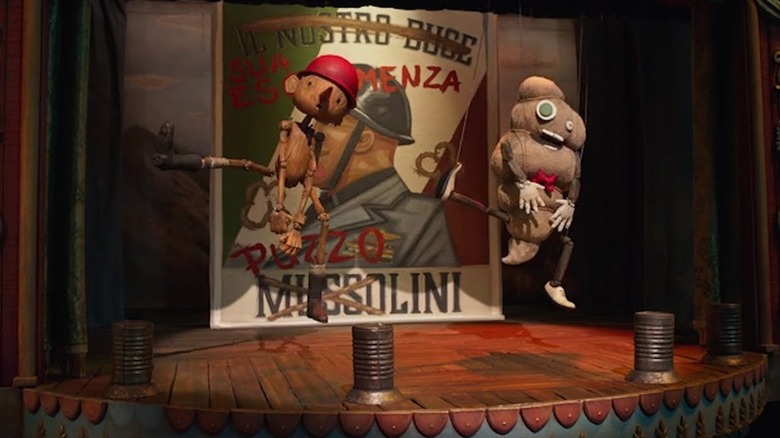
When we first heard that Guillermo del Toro, the director of "Pan's Labyrinth," was set to direct another dark fairytale -- an adaptation of "Pinocchio" set in Fascist Italy -- there was a natural expectation of some sober sociopolitical commentary. And the movie does indeed have that: it explores how the moral lesson of obedience as a virtue becomes problematic in a society where obedience is enforced by, and complicit with, suffering and tyranny. This theme is already well-established by the time a stop-motion version of Benito Mussolini (voiced by Tom Kenny, the voice of Spongebob Squarepants) arrives on the scene for a special show prepared for him by the villainous, brown-nosing Count Volpe (Christoph Waltz).
Right before the show, Pinocchio (Gregory Mann) decides to rebel and conspires with the carnival's resident monkey puppeteer Spazzatura (Cate Blanchett) to compose a new version of the jingoistic "Fatherland March" song. You might be expecting a searing political diatribe, decrying Mussolini's war crimes and authoritarian rule. But Pinocchio has only been alive for a few months, and he doesn't really keep up with politics. So the song he composes is about how Mussolini is a big baby who poops his pants. (Sample lyrics: "Like a bag of poop/Magnificent and free/You are farting, farting/In the men's lavatory.")
It's nonsensical and crudely hilarious, and also there's a dancing poop puppet with a bow tie. At one point Pinocchio mimes pooping into a helmet. Now this is cinema. (Hannah Shaw-Williams)
25. Elvis Chooses To Wiggle (And Gets Arrested) In Elvis
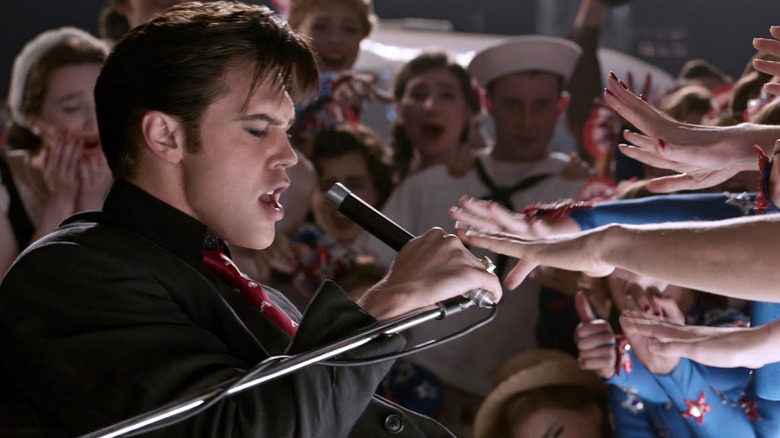
Baz Luhrmann reimagines the story of Elvis Presley as only he can — with big, over-the-top mania. Early in the King's career, we see him getting in trouble for taking to the stage and wiggling his hips as he sings — an action that drives ladies wild with lust. Elvis is told time and time again by his evil manager (Tom Hanks, really hamming it up) to stop wiggling or there will be consequences. But Elvis has to wiggle, man! And so, during a big stadium concert, he takes the stage and proceeds to wiggle his heart out — a move considered so obscene that the cops actually haul him away. But that won't stop Elvis. Oh no. He'll wiggle until he can't wiggle no more, baby. It's a celebration of excess, and that's what "Elvis" is all about. (Chris Evangelista)
24. Climbing The Mountain, Twice In Decision To Leave
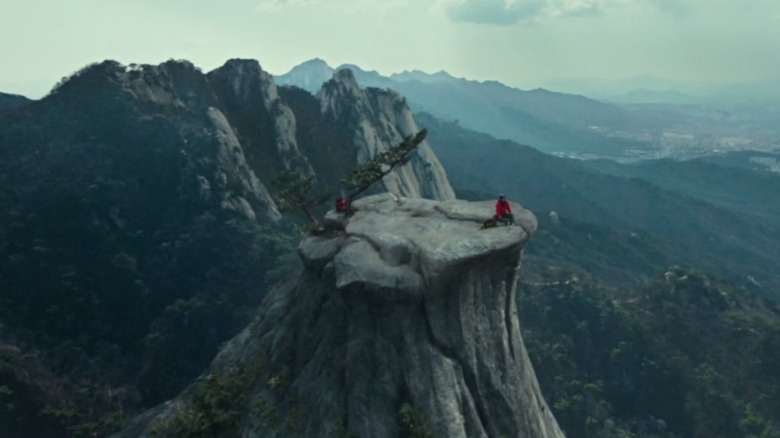
For the first hour of "Decision To Leave," the audience and Detective Jang Hae-jun (Park Hae-il) are unsure: did Song Seo-rae (Tang Wei) murder her abusive husband? Ki Do-soo (Yoo Seung-mok) was found dead at the base of a mountain — was the death a rock-climbing accident, a suicide, or a murder?
When Hae-jun discovers proof of Seo-rae's guilt, he retraces her steps. What follows is the film's most intricate editing as three people head up the mountain: Do-soo and Seo-rae in the past, and Hae-jun retracing their steps in the present. The film employs cross-cutting and match cuts to combine the two climbs into one sequence. We thus see the murder carried out as Hae-jun confirms how it happened: Seo-rae swapped phones with one of her elder care patients (to keep the step count off her own phone), climbed the mountain on a different path than Do-soo took, and hid in a crevice. When her husband reached the top, she followed then pushed him to his death.
When Hae-jun reaches the peak, he takes out his phone and checks his step count; it's the same as Seo-rae's, 138 flights. His phone screen is superimposed over his face so viewers can take in the information and his emotions all at once. Rather than excited about cracking the case, he's shattered because a woman he's come to love is the killer he's been hunting. (Devin Meenan)
23. Marcel Realizes How Big The World Is In Marcel The Shell With Shoes On
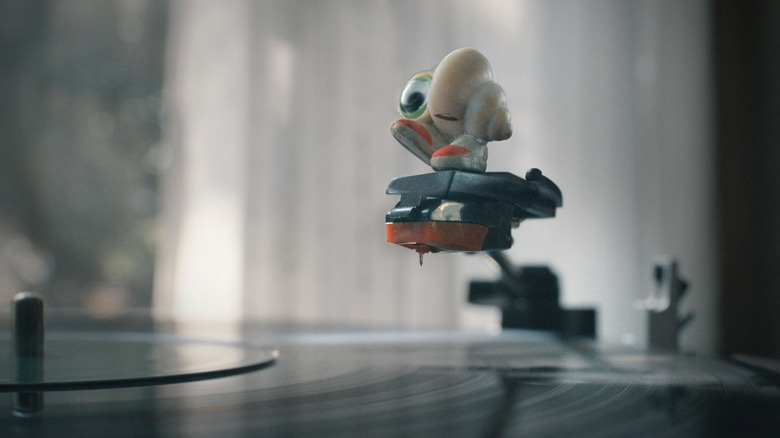
For Marcel, a one-inch tall shell who lives in a full-sized human house, his world feels massive. Traveling from one room to the next takes forever unless he travels inside a rolling tennis ball, and traversing immense heights requires clever workarounds, like stepping in honey and using the stickiness to walk straight up the walls. But when most of Marcel's family goes missing and he teams up with his old human pal Dean Flesicher-Camp to try to find them, Marcel leaves the house for the first time and rides on the dashboard of Dean's car, cruising around the endless sprawl of Los Angeles. Standing on top of a map of the city as he watches neighborhoods whiz by out the window, it dawns on Marcel that the world is exponentially bigger than he possibly could have comprehended. It's like watching a kid processing the fact that Earth is only one planet in a larger universe for the first time, and Marcel is in complete awe. But with that eureka moment comes the heartbreaking realization that his quest to find his family has just become infinitely harder. Everything works out in the end, but watching Marcel quietly come to that conclusion is one of the saddest cinematic moments of 2022. (Ben Pearson)
22. Trying To Get A Single Good Take For A Talkie In Babylon
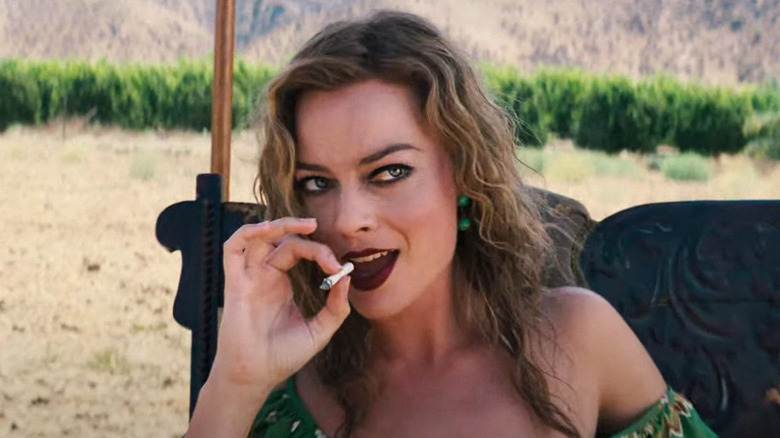
Damien Chazelle is terrific at repetition. There's an electricity crackling through his films, juiced up by quick cuts and perfectly placed insert shots, and he's able to convey a sense of speed and energy in high-pressure situations. In the late 1920s, as silent films give way to the talkies, Margot Robbie's movie star character in "Babylon" has to navigate the new normal of making movies with sound, and what should be a simple dialogue scene becomes a crucible for a filmmaking team that is trying to adjust to this new world order in real time. Take after take, something gets screwed up: Nellie doesn't hit her mark, the microphone isn't positioned correctly, something squeaks on the set and ruins the take. All the while, the temperature is rising as hot lights glare down on everyone, and a camera operator is locked inside an airless, soundproof booth trying to capture the scene without ruining the audio with loud camera noise. Tempers flare, screaming matches occur, and for about 10 minutes, Chazelle uses his skill at repetition to show the audience just how painstaking the act of making a movie can be. Films are minor miracles, he seems to be saying, and even if terrible things sometimes happen just off-screen, the achievement of capturing the moment will live on. (Ben Pearson)
21. The Ending Of Guillermo Del Toro's Pinocchio
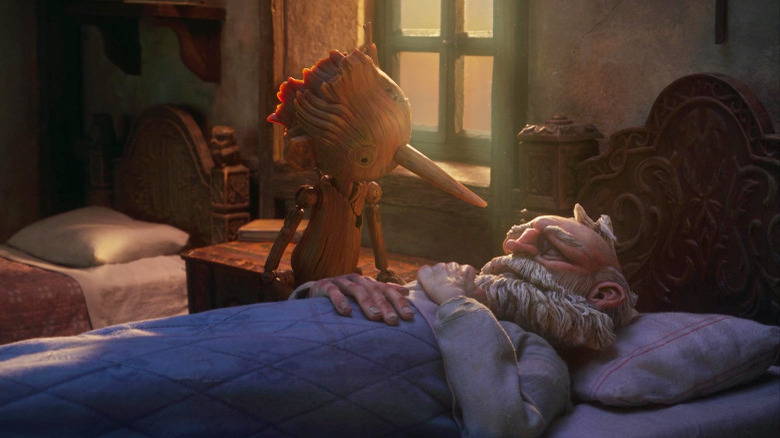
Carlo Collodi's "The Adventures of Pinocchio" is disappointingly backward and conservative for such a beloved fairy tale, from the way it tries to scare kids into never questioning authority figures to the fact that it's all about Pinocchio's quest to change his very essence rather than being accepted for exactly who and what he is. Unsurprisingly, the artist who gave us socially progressive fables like "Pan's Labyrinth" and "The Shape of Water" has no time for such nonsense in "Guillermo del Toro's Pinocchio," a film that packs quite the emotional punch in its closing moments.
As in other retellings, del Toro and co-director Mark Gustafson's "Pinocchio" ends with its namesake sacrificing his life to save his found family, allowing him to become "real." Except, "real" people can't die and come back, as the movie reminds us, which is why Geppetto and Jiminy Sebastian J. Cricket (having seen the error of their efforts to mold him) beg the Sprite who gave the puppet life in the first place to resurrect him just as he was. The underlying message is an endorsement of otherness, as Pinocchio goes on to outlive his loved ones after making the most of their remaining days together. It's also a poignant reminder that what we choose to do with our limited time in this mortal realm is the very thing that gives our lives purpose. The radical spirit of youth, which Pinocchio embodies, will carry on, long after we're gone. (Sandy Schaefer)
20. Making A Cheeseburger In The Menu
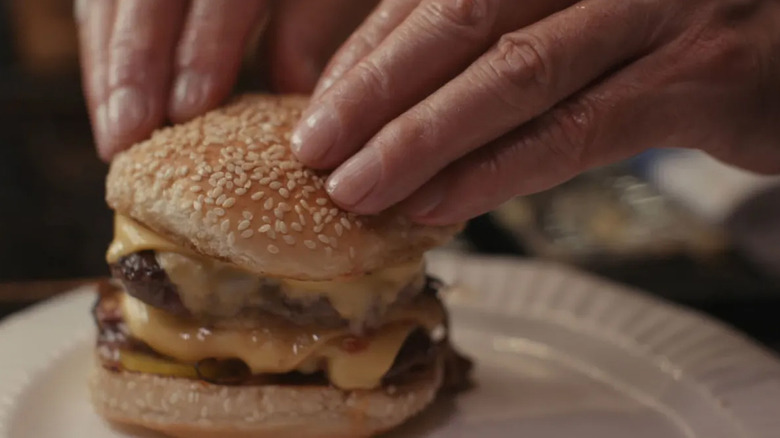
After I walked out of "The Menu," I hit up the nearest A&W takeout window and bought a cheeseburger — the first time I've bought beef to eat in (checks notes) ... almost 20 years. (I am old.)
Is my willpower waning in my 30s? Am I just very impressionable? Honestly, I think both are true — but let's not discount how sexy that burger looks in "The Menu." Directed by Mark Mylod, the film is a dark comedy thriller that pokes fun at foodie culture and extreme fine dining. After an hour and a half of increasingly unappetizing dishes, prepared for appropriately unappealing guests, Chef Julian Slowik (Ralph Fiennes) returns to his roots at the request of "Margot" (Anya Taylor-Joy), the only relatable and remotely likable person on this whole private island. Setting aside all the pretension, he lovingly prepares a tender, juicy, melt-in-your-mouth burger — even finishing the dish with a gentle press to show the slight trickle of delicious flavor dripping from the meat. Of course, this is all blown up on the big screen in close-up, inviting the audience to drool over the best gat-dang cheeseburger ever filmed.
I even wrote about the "slutty cheeseburger" in my personal "Top 10 Films of 2022." It's kind of the movie's climax, but more importantly, it's the most memorable, stand-out moment in a film full of shocking turns, laugh-out-loud quips, and unforgettable dishes. (Sarah Milner)
19. Swimming With The Tulkun In Avatar: The Way Of Water
If there's anything that both fans and detractors alike can agree on about the "Avatar" movies, it's that they were made with one predominant goal in mind: to inspire feelings of grandeur and awe and transport them to another world entirely. In "Avatar: The Way of Water," however, it's not the opening attack on Pandora by a returning army of humans or the climactic final battle that draws the most attention. It's a simple ocean-set sequence where Jake Sully's (Sam Worthington) young Na'vi son Lo'ak (Britain Dalton) first comes across movie's scene-stealing addition: the castaway Tulkun named Payakan.
Most impressive of all is how even scenes like this one advance the movie's themes. The rebellious Lo'ak, who doesn't feel he belongs with either his family or the seafaring Metkayina community at large, chances upon the one creature on Pandora who best understands how he feels. After some mean-spirited Metakayina youths play a cruel prank on Lo'ak and leave him to fend for himself out in the middle of their local reef, Payakan shows up in the nick of time to save Lo'ak from one of Pandora's most dangerous aquatic carnivores. In the aftermath, Lo'ak realizes that the whale-like creature is far more sentient and has far more in common than he assumed. In a wonderfully stirring and evocative dance, Cameron hits us with one of the sequel's many jaw-dropping visuals as Na'vi and Tulkan are linked as one. (Jeremy Mathai)
18. Discovering Yang's Past In After Yang
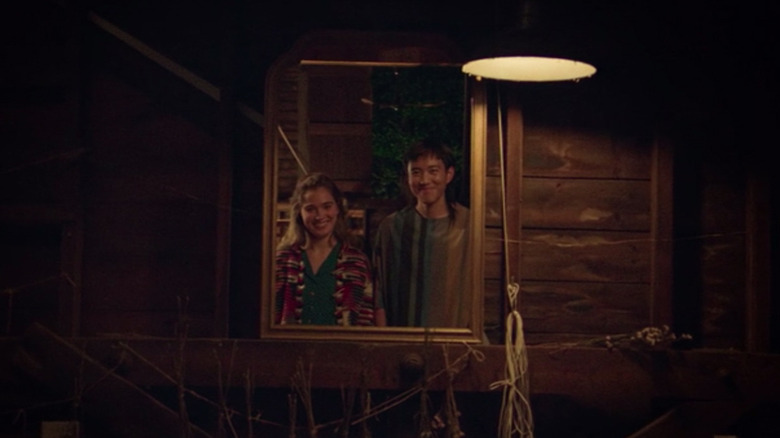
In "After Yang," a family is mourning the apparent loss of their young daughter Mika's beloved companion, a teen android named Yang. The android was designed as a glorified babysitter who would help the young Asian girl learn about her own culture after being adopted by her non-Asian parents (Colin Farrell and Jodie Turner-Smith as Jake and Kyra). When Yang malfunctions and it appears there's no way to fix him, Jake learns that Yang is much more than his daughter's companion. Yang has actually lived several lives before he came to accompany Mika, and as Jake attempts to figure out how to fix him, he discovers the android's heartbreaking past.
Utilizing what is essentially a virtual reality operating system, Jake digs into the compressed memory files of Yang's previous lives. It turns out Yang is a sophisticated prototype android given the ability to select small memories to preserve throughout his life, recorded in clips that last for only a few seconds. Jake navigates Yang's memories to discover a plethora of beautiful, brief clips from his past, revealing the families that he lived with, innocuous things that he thought to be beautiful, and the presence of a young woman (Haley Lu Richardson) who he may have come to love. The series of images that unfurl from Yang's mind are mesmerizing and lovely, and it reminds us of the everyday beauty in the ordinary moments in life that we frequently overlook. (Ethan Anderton)
17. Colm Speaks To The Priest In The Banshees Of Inisherin
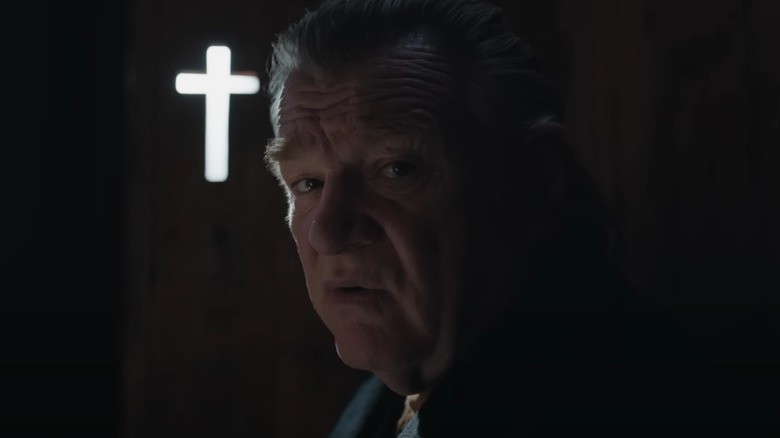
The early parts of "Banshees of Inisherin" are about the frustrations of Pádraic (Colin Farrell) over how his friend Colm (Brendan Gleeson) has stopped talking to him. We're introduced to Colm through Pádraic's eyes and we only start to see things from the other side when Colm goes to confession.
Colm confesses to, "drinking and the impure thoughts... and a bit of pride, I suppose, though I never really saw that as a sin." Colm is a musician, so pride in his work comes naturally to him, but pride is a refusal to admit you're wrong. As the movie goes on, we learn that is indeed his sin.
One of McDonagh's talents is how he writes conversations going off the rails, and that's what happens here. The Priest (David Pearse) asks if Pádraic is the source of Colm's impure thoughts. An Infuriated Colm throws the question back at the Father and they end the confession in a screaming match, Colm's sins unabsolved.
Yet before he broaches the topic of Pádraic, the Priest asks Colm: "How's the despair?" Colm isn't spiteful, he's depressed and he's clearly been this way for a while. McDonagh shoots the conversation in alternating close-ups, never placing actors in the same frame. They're close, but still divided, just like everyone on the lonely island of Inisherin. (Devin Meenan)
16. Raccacoonie In Everything Everywhere All At Once
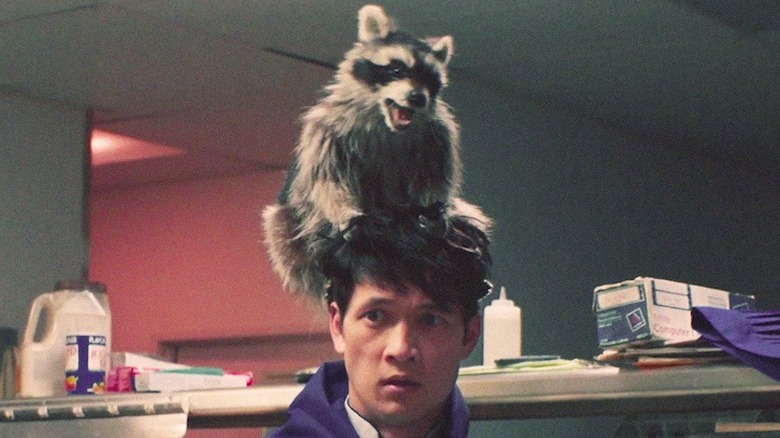
The first time you hear "Raccacoonie" in "Everything Everywhere All At Once," it appears to just be a quick throwaway joke. Having recently made contact with the multiverse, Evelyn (Michelle Yeoh) tries to explain the mechanics of it to her husband and daughter using a movie she vaguely remembers as an analogy -- you know, the movie "Raccacoonie," about a chef whose skills rely entirely on a raccoon sitting under his hat and pulling his hair to control him like a puppet.
But in the vast ocean of the multiverse, just about every type of universe exists: a universe where people have hot dog fingers; a universe where organic life never sprouted and Earth is just full of rocks; a universe where Evelyn is a piñata. And yes, there's a universe where she's a top chef whose leading competition is Chad (Harry Shum Jr.), a young hotshot secretly being controlled by a raccoon under his hat.
There are a lot of great Raccacoonie moments in "Everything Everywhere All At Once." This particular subplot actually ends up becoming rather heart-wrenching when Chad's secret is exposed and Raccacoonie is taken away by Animal Control. But easily the top moment is that first reveal of Chad and Raccacoonie as they are discovered by Evelyn -- Raccacoonie (voiced by Randy Newman, yes, that Randy Newman) growling "she's seen too much" and puppeteering Chad's body to attack Evelyn while the audience's brains are still coming to terms with what their eyeballs are serving up to them. It's pure Daniels madness. (Hannah Shaw-Williams)
15. Maverick Proves The Mission Can Be Done In Top Gun: Maverick
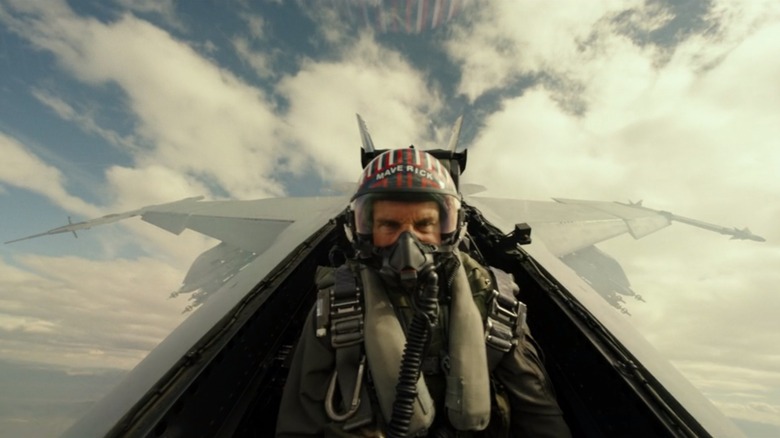
"Top Gun: Maverick" was practically engineered to become a smash-hit, featuring Tom Cruise's past-his-prime Pete "Maverick" Mitchell recruited to teach a cadre of hot-shot aviators how to pull off a suicide mission. But no scene better sums up the crowd-pleasing strengths of the legacy sequel than when grizzled ol' Maverick comes out of nowhere to prove that it can actually be done.
Notably, this only comes when our hero is at his utterly lowest moment. Reeling from the near-deaths of three trainees, a gut-punch argument with Miles Teller's Bradley "Rooster" Bradshaw (the son of Maverick's late wingman from the original, Goose), and the tragic passing of Val Kilmer's Ice Man, Maverick is kicked out of his teaching role in disgrace, leaving the cadets to figure it out on their own. That is, until he steals a multi-million dollar jet and hits the training course to give them (and us) some much-needed hope.
The aerial footage of Cruise actually piloting his fighter is thrilling enough, but really it's the masterful editing by Eddie Hamilton and Chris Lebenzon that puts this sequence into the stratosphere. When we repeatedly cut to reactions of the cadets literally leaning forward and ready to jump out of their seats as Maverick successfully navigates each stage, interwoven with pulse-pounding visuals and literal ticking clocks, it's no surprise that we find ourselves doing the same. That's how you do catharsis. That's the magic of the movies, baby. (Jeremy Mathai)
14. The Final Fight In Prey
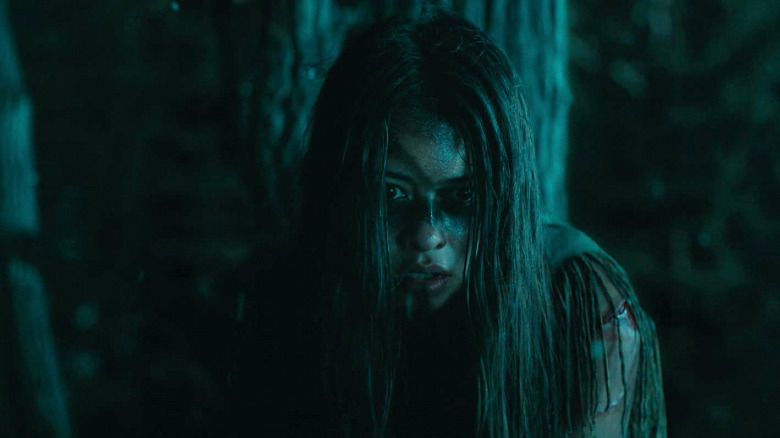
There's a lot about "Prey" that makes it an effectual back-to-basics entry for the "Predator" films after the confused mess that was 2018's "The Predator." (Shane Black -- mostly -- innocent!) Above all else, director Dan Trachtenberg's enthralling prequel, which plays as the best parts of "The Revenant" mashed together with a grisly monster movie, remembers that it wasn't firepower or sheer force of will that saved the day in John McTiernan's original 1987 "Predator" film. It was only when Arnold Schwarzenegger's macho Vietnam War veteran Dutch realized he would have to rely on his skills of observation and surroundings rather than his muscles that he found a way to outmaneuver his alien opponent.
Amber Midthunder's Comanche warrior Naru has the same epiphany heading into the climax of "Prey." Having tried to go toe-to-toe with her brother and his fellow male hunters physically earlier on in the movie only to fall flat on her face (somewhat literally), Naru learns her lesson and takes the time to study her extraterrestrial enemy over the course of their various encounters, as well as the ways she can utilize any and all available resources to her advantage. She then proceeds to lead the Predator into the bog she previously stumbled upon, using one of the French fur trappers' severed limbs as bait and ultimately tricking it into killing itself with its own spear gun. It's a deeply satisfying payoff to the character's arc and a cathartic cap-off to the film's anti-colonialism themes to boot. (Sandy Schaefer)
13. Miles Bron Is An Idiot In Glass Onion
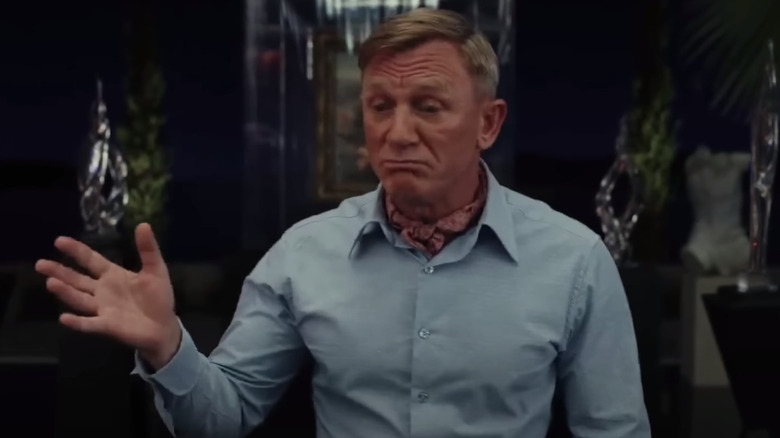
Mirroring billionaire Elon Musk's hilarious Twitter downfall may have been a total accident, but making the "genius" at the center of "Glass Onion" a total idiot was much more intentional. Writer and director Rian Johnson wanted to skewer the tech billionaires of the world the same way he had satirized "old money" in "Knives Out," and he did it brilliantly by making his movie's antagonist, Miles Bron, a secret dummy who pretended to be smart.
Edward Norton plays Bron in a way only Norton ever could. He's smarmy and spoiled, but there's something almost sweet about his stupidity. There are shades of Norton's performance as kids' performer Sheldon Mopes in "Death to Smoochy" in Bron, bringing his neuroses and doe-eyed doofiness to a much more sinister role. When detective Benoit Blanc (Daniel Craig) finally loses his cool and points out that Bron is an idiot, one of his friends tries to say that an idea of his is "so dumb that it's brilliant," and Blanc has to correct her — "No, it's just dumb."
People tend to assume that filthy rich tech bros have to be smart to have made it so far in their industries, but sadly, that's not the case. Blanc's exasperation is relatable, and hopefully the memes made from this scene will help prevent future generations from falling for the words of another moron with lots of money and a tight smile. (Danielle Ryan)
12. The Prison Escape In RRR
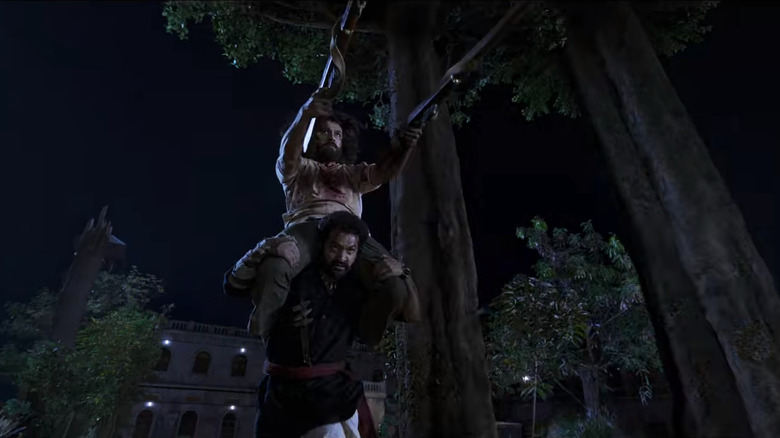
This list could very well could have been a scene-by-scene description of everything that happens in S.S. Rajamouli's anti-colonialist epic "RRR." Of course, other films also came out in 2022, so we needed to narrow it down a little. Unquestionably, one of the most inventive and spectacular set pieces across that film's three hour running time is when N.T. Rama Rao Jr.'s Komaram Bheem helps break Ram Charan's Alluri Sitarama Raju out of prison after learning why his best friend betrayed him in service of the British. We have seen plenty of prison break sequences in films before, but never in this manner.
Because Raju's legs have been completely battered by the British prison guards, he is unable to use them in the escape, requiring Bheem to carry him on his shoulders in a callback to their friendship bonding montage from earlier in the film. When the two men essentially become one body, they become more powerful than anyone could imagine, like Voltron. They are completely in sync with each other to be able to take out dozens of prison guards — either with the use of guns or just pure brute force — and can run and leap through the air like a superhero. Raju firing off rifles in each hand, followed by Bheem instinctively releasing the shell casings, is one of the more fist-pumping moments in a movie packed to the brim with them. And this isn't even the film's climax! (Mike Shutt)
11. The First Appearance Of Batman In The Batman
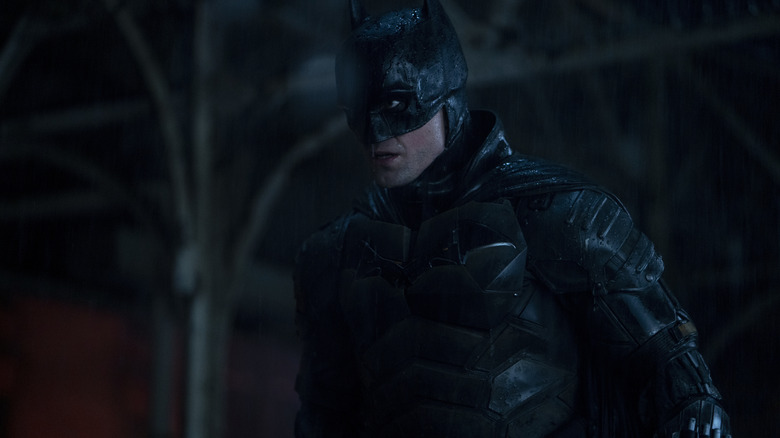
Any new iteration of Batman on the big screen needs to make a memorable first impression, and Matt Reeves pulled out all the stops to ensure that Robert Pattinson's debut in "The Batman" was worthy of the cape and cowl. The pitch-perfect narration informing viewers of the film's distinct status quo, incognito Bruce Wayne's slow-motion walk through the crowded and rainy streets of Gotham on Halloween night, and a tableau of petty crimes across the city linked by the perpetrators looking over their shoulders and up to the sky in dread all help set the mood for the grungiest, most emo Batman yet. And all that comes before we ever even get a glimpse of the bat in black.
Fittingly enough, Reeves plays a little cat-and-mouse game with our expectations. By putting us squarely in the shoes of the bad guys and lingering on every dark alley and shadowy doorway, it's as if Batman could step out at any moment like a ghostly deterrent. The crime-in-the-making that receives the most attention, however, is a face-painted gang targeting an Asian man on the subway. Although depicting a would-be hate crime understandably hits too close to home for many, choosing this as Batman's first appearance speaks volumes. Dispatching the gang with brutal efficiency but absorbing his fair share of punishment as well, it's clear that this Batman terrifies the guilty and innocent in equal measure. As Bruce puts it himself: "Fear is a tool." (Jeremy Mathai)
10. Ugly Sonic In Chip 'N Dale: Rescue Rangers
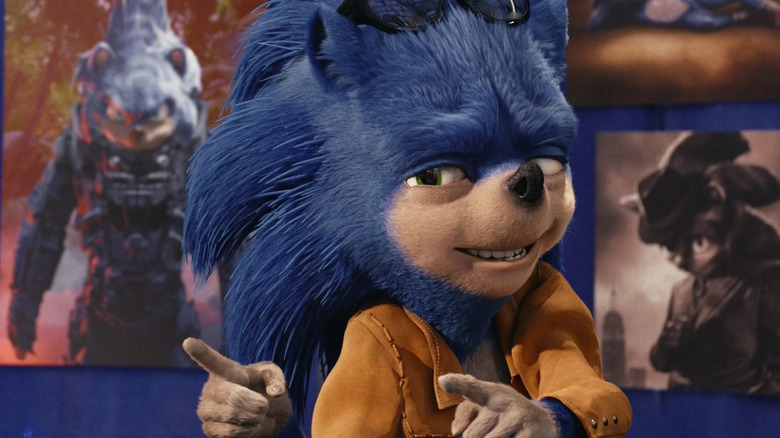
For a long time, Jar Jar Binks was easily the most reviled computer generated character to grace the screen. But for a brief time, a certain spiny mammal felt the full wrath of the internet. When the original character design for Sonic the Hedgehog debuted in the first teaser trailer for the video game character's big screen adaptation, audiences were horrified. The backlash against the character was so fierce that director Jeff Fowler responded just a few days later to console everyone that their criticism had been heard and the character design would be completely overhauled. It might sound like a nightmare, but their unfortunately misstep is our gain.
Rather than being relegated to the annals of computer generated misfires from Hollywood history (we're looking at you Scorpion King), the character dubbed "Ugly Sonic" will forever live on as one of the best comedic bits we've ever seen. Voiced by Tim Robinson, the original "Sonic the Hedgehog" character design -- with his unsettling human teeth and hairy, ungloved, five-fingered hands -- appeared in "Chip 'n Dale: Rescue Rangers" as a chump resigned to taking pictures and signing autographs with "fans" at pop culture conventions. Ugly Sonic is a total bro, but it's hard to register anything beyond those creepy teeth and eyes spaced too far apart. This is an absolutely hilarious gag that fits perfectly within the meta context of the Disney+ movie that's a worthy successor to "Who Framed Roger Rabbit." (Ethan Anderton)
9. The Animals Unleased In RRR
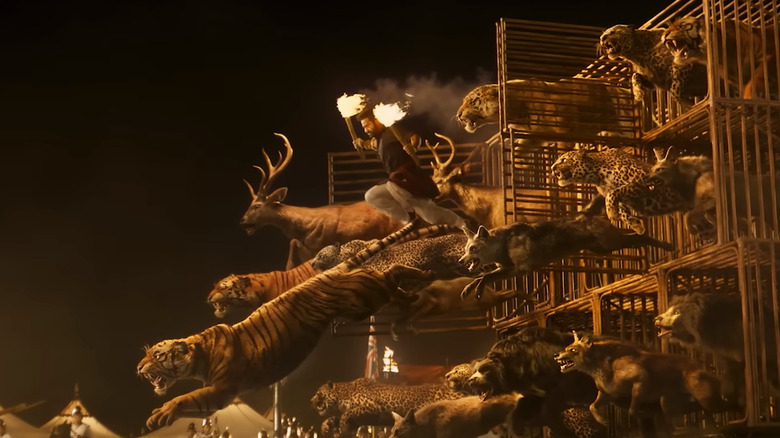
Far more articulate folks than I have talked about the cinematic wonders of "RRR," and lovers of cinema will continue to do so for years to come -- and rightfully so. But for people like me, the popcorn-eating, blockbuster-loving moviegoers of the world, the animal breakout scene at the manor that comes about halfway through the movie illustrates why director S.S. Rajamouli's film is a cut above the rest. When our hero busts through the gates of that manor riding on the roof of a truck filled with exotic, deadly animals, carrying only a couple of torches to protect him from their fury before all hell breaks loose, it's as cheer-worthy as movies get. Then the viewer has the wonderful, sober realization after all of the madness unfolds that we are merely halfway through this balls-to-the-wall epic, with so much more action for the ages to come. For those who were lucky enough to see this in a theater like myself, it was a religious experience and this was the moment when so many of us understood that we were going to worship at the altar of "RRR" from here on out (Ryan Scott).
8. Pearl's Monologue In Pearl
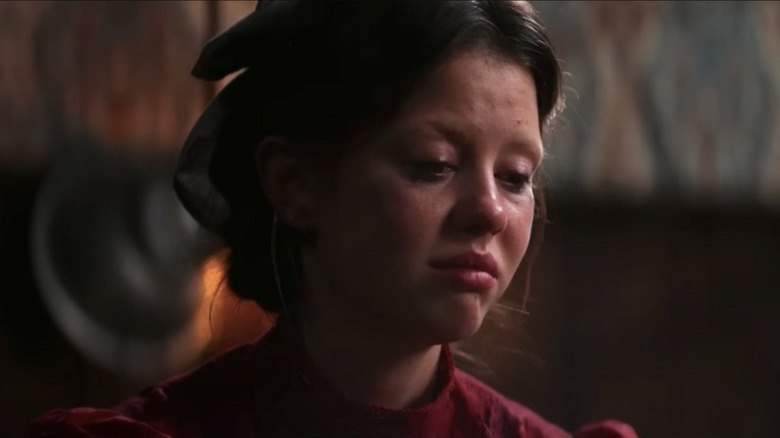
In terms of the horror genre, 2022 was the year of Mia Goth. Fans were dazzled when she starred as Maxine Minx in Ti West's throwback slasher, "X," and were blown away to discover she was playing double duty as Pearl, an elderly woman with an intense hatred for the young pornographers renting out her farmhouse. Goth was the perfect, subversive final girl and a terrifying portrait of the "psycho-biddy" films of yesteryear, and we couldn't get enough. Fortunately, West had "Pearl" up his sleeve, a prequel film where Goth played the 20-something version of her elderly character, set in 1918.
"Pearl" is a technicolor nightmare that plays out as if Dorothy Gale would have done absolutely anything to fly over the rainbow, with Goth appearing in every single scene. The movie lives and dies by her performance, which is undoubtedly Oscar-caliber, but won't get the respect it deserves for existing in a horror film. The climax of "Pearl" is a harrowing monologue, where Goth expresses why Pearl has committed the atrocities she has, imagining that she is confessing her sins to her husband, Howard. Goth's performance demands to be seen, and the camera seldom leaves her devastated face. It is the unquestionable horror performance of the year and a monologue that will be hailed in the future as a landmark in genre history. (BJ Colangelo)
7. Pádraic Makes The Case For Kindness In The Banshees Of Inisherin
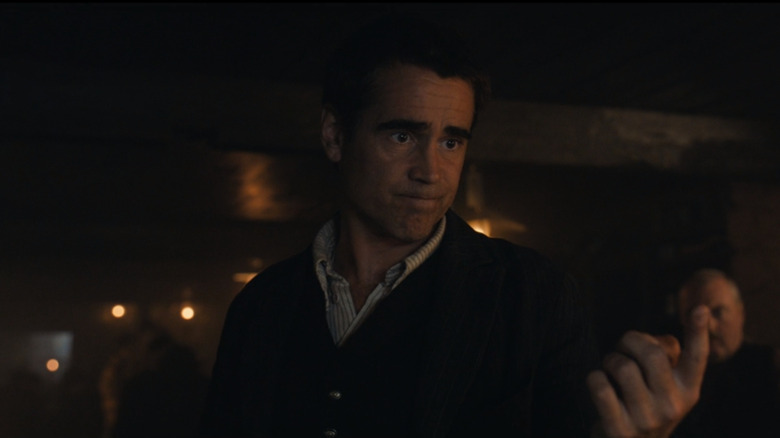
Few things in this world hurt like the end of a friendship, and when that friendship has lasted a lifetime, the pain is truly bitter. In Martin McDonagh's "The Banshees of Inisherin," Pádraic (Colin Farrell) is heartbroken when his best friend Colm (Brendan Gleeson) suddenly decides that he wants nothing to do with him. Pádraic wants to know why Colm cut him off, arguing that he's one of the nicest people on the island. Nice, according to Colm, is boring, and Pádraic is boring, but Farrell's impassioned pleas as the "nice" Pádraic are truly painful. He can't understand why his niceness isn't enough, or that his complacency with his own life means that others will have to pass him by.
"The Banshees of Inisherin" is a tragic comedy, and Pádraic's attempt to make a case for himself, and for niceness, is definitely on the tragic end of things. Tears well in his eyes as he tells Colm about all of the nice people he's known and loved, and Colm tells him that no one will remember those people, no one will remember any of them. Niceness isn't remembered.
Then again, maybe if Colm had practiced a little bit of being nice himself, the film's many tragedies may never have happened. Maybe Pádraic was onto something, even if he was a bit dull. (Danielle Ryan)
6. The Ending Of The Fabelmans
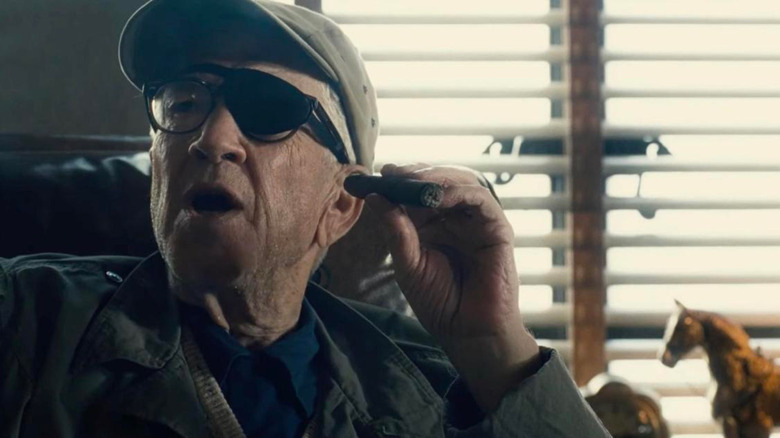
When Steven Spielberg was a young lad trying to break into the movies he had a chance encounter with legendary director John Ford. Ford, director of "Stagecoach" and so much more, gave the young Spielberg some advice — and when Spielberg set about bringing his childhood story to the screen in "The Fabelmans," he made sure to recreate the Ford incident. Here, David Lynch perfectly plays Ford, leaning into the filmmaker's surly nature as he tells Spielberg's avatar, Sammy Fabelman, all about the pictures. By which I mean he has Sammy look at some paintings of cowboys and tell him where the horizon is. The answer: never in the middle. Because having the horizon at the top or bottom of the frame is interesting, and having it in the middle is boring. And sure enough, after being dismissed by Ford, Sammy wanders onto a production lot and Spielberg has the last laugh — the horizon in the shot starts off directly in the center, only for Spielberg to take his mentor's advice and suddenly lower it. Why? Because that's interesting. (Chris Evangelista)
5. OJ Waits Out The 'Rainstorm' In Nope
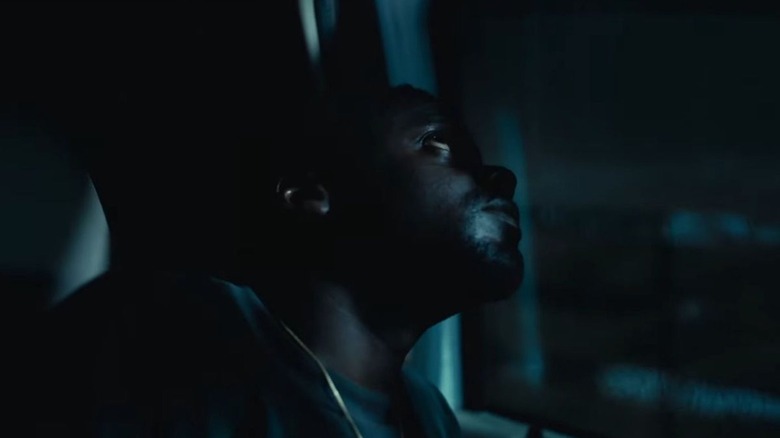
"Nope" is a brilliant horror movie about exploitation and spectacle, and how humans are drawn to darkness by default. Like Jordan Peele's previous movies, it's loaded with enough subtext to fill a few college courses. But also like Jordan Peele's previous movies, it's so scary, so thrilling, and so funny that it never feels like you're eating your vegetables. Peele's gifts as a filmmaker are on full display in a key scene where Jean Jacket, the alien being that has been terrorizing the land surrounding the Haywood ranch, uh, releases its leftovers. Blood, gore, and undigestible bits and bobs from its latest meal of humans and horses rain from the sky, soaking the ground and turning the house itself a crimson shade. As this horrifying image unfolds, the taciturn OJ (Daniel Kaluuyaa, doing so much with a character of few words) sits in his truck, wild terror somehow creeping through his ever-stoic face, and calmly locks his door. "Nope," he mutters as he observes the sheer outrageous horror right outside his automobile. It would be the scariest scene of the year if it also wasn't one of the funniest. (Jacob Hall)
4. Measuring The Basement In Barbarian
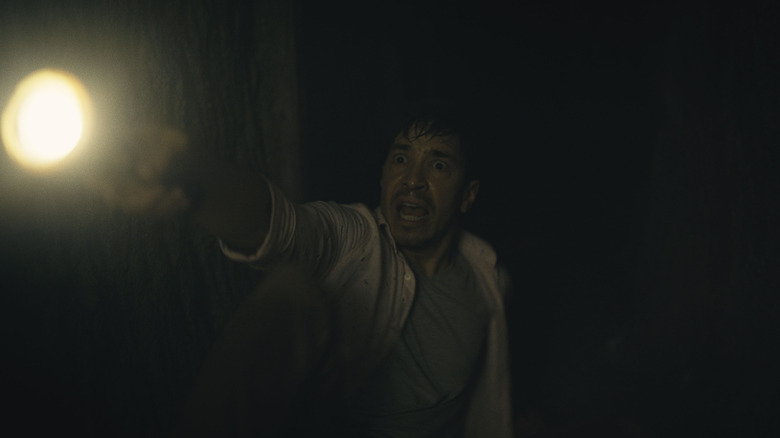
If we were to hand out an award for most surprising movie of 2022, it would almost certainly go to "Barbarian." Director Zach Cregger's descent-into-craziness horror flick was about as unpredictable and bonkers as mainstream movies get. Perhaps nothing illustrates just how much this movie swung for the fences then Justin Long's sequence in the middle of the movie, where we meet him as A.J., an actor who is desperate for cash (due to his alleged transgressions) and is trying to sell some of his property in Detroit. When he discovers the basement of horrors that Tess (Georgina Campbell) discovered in the first half of the film, his reaction is not one of terror -- it's one of potential profit. Thus, the man busts out a tape measure and attempts to figure out just how much value this caverness maze made of nightmare fuel could add to his property. His descent into the den of horrors is brought on by greed, and it's an utterly hilarious, profoundly bold moment in the midst of an otherwise horrific film. A true masterstroke in the art of releasing tension before ratcheting things right back up again. (Ryan Scott)
3. A Friendship Is Formed And The Late Title Drop In RRR
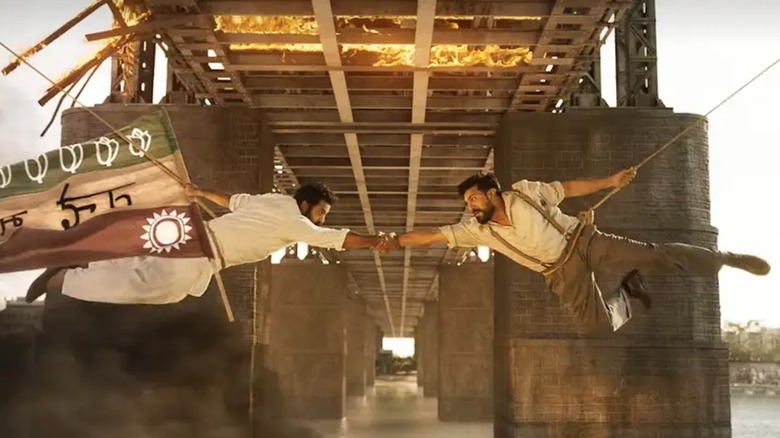
A young boy is in peril. A train has exploded, leaving the child stranded under a bridge and powerless to move as fire closes in. Thankfully, Raju and Bheem are on the scene. They've never met each other, but this situation calls for two men to rise to the occasion, and there's never any question that these two are going to get involved. Using a series of vague hand signals that should be totally indecipherable but which foreshadow this pair's imminent friendship, the two men communicate a plan to each other. Both will grab the ends of a rope, ride toward each other atop the bridge at top speed, and at the last second, they'll leap off the opposite sides perpendicularly, swoop downward, one will wet a flag in the water under the bridge, the other will grab the boy, they'll hurl each item toward the other in mid-air, Raju will toss the boy to safety, Bheem will swing into flames protected by the wet flag, and when their makeshift pendulum swings back toward the middle, they'll grab wrists and become best friends for life.
Do they pull off this ridiculous plan? You're goddamn right they do. The only thing that could make this better is a late title drop immediately afterward, and you bet your ass that happens, too. (Ben Pearson)
2. Naatu Naatu In RRR
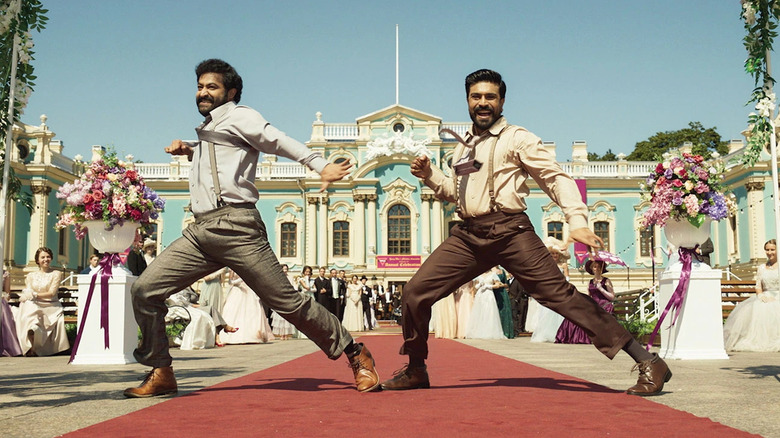
S. S. Rajamouli has been consistently putting out remarkable cinematic epics for decades, but "RRR" is his magnum opus. Everything you've ever heard about "RRR" is true, and it's one of the few films in existence that can't be ruined by hype. No matter how many people have screamed "this is the best movie ever" from the rooftops, no one is truly prepared for the mind-melting awesomeness of "RRR." Brimming with action, adventure, and anti-colonialism, "RRR" has all of the powerhouse signatures of an epic story. However, as this is a Tollywood film, it also includes one thing that most American/Eurocentric epics do not — song and dance.
"Naatu Naatu" has already been picking up statues this awards season for Best Original Song, and it will be unsurprising if it takes home the Oscar. But "Naatu Naatu" isn't just a banger of an earworm, it's also one of the most perfect showcases of choreography-as-storytelling in recent memory. Singing and hook stepping along to "Naatu Naatu" revitalizes a time-honored tradition of audience participation scenes like "The Time Warp" in "The Rocky Horror Picture Show" and does so while appearing in a film filled with enough badass moments to constitute its own Best Of list. "Naatu Naatu" allows dance, joy, friendship, and fun to carry the same weight of importance as a violent battle, which quite honestly, is good life advice as well. (BJ Colangelo)
1. 'Laundry And Taxes With You' In Everything Everywhere All At Once
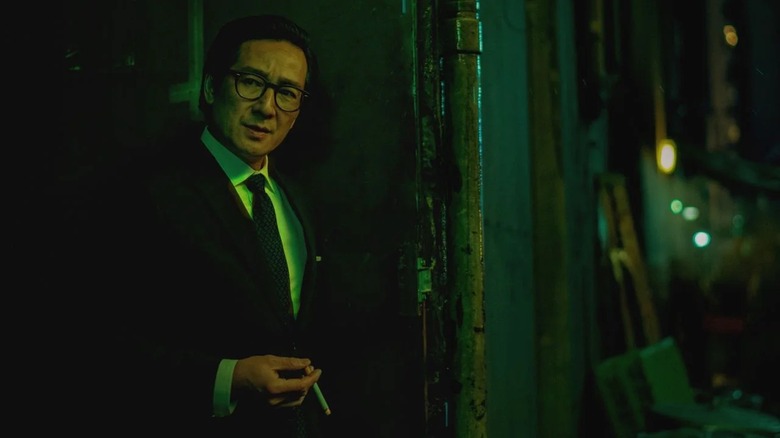
"So, even though you have broken my heart yet again, I wanted to say, in another life, I would have really liked just doing laundry and taxes with you."
With one line of dialogue, Ke Huy Quan shatters our hearts but also mends them. "Everything Everywhere All At Once" is a movie about chaos, a universe-jumping science fiction action adventure about the fragility of existence, but it's also a movie about love, kindness, connection, and taking control of your own life in a world increasingly constructed on a wobbly tower of pain and distraction. An alternate universe version of Waymond Wang -- composed, debonair, looking like he stepped out of a Wong Kar-wai movie -- makes it clear to Michelle Yeoh's Evelyn (a movie star in this particular universe) that the life she sees as so disappointing is one that would've brought him great joy. He loves her. He will always love her. He will love her in every universe, even if their lives revolve around laundry and taxes.
It's the moment that brings "Everything Everywhere All At Once" into focus. Through the mayhem, through the zany comedic set pieces, through the wildly-fluctuating tone, directing duo Daniels reveal that they've made a movie about how it's possible, and necessary, to find love and connection in a world on fire. (Jacob Hall)
Read this next: The 30 Most Anticipated Movies Of 2023
The post The 50 Best Movie Moments of 2022 appeared first on /Film.
